Cats
5 Steps to Calm an Overstimulated Cat
Tackle signs of overstimulation in cats with these 5 calming steps to create a peaceful environment and help your feline friend relax.

To calm an overstimulated cat, observe signs like tail twitching, restlessness, and dilated pupils. Create a safe haven by removing stressors, providing comfy bedding, and a quiet, dimly lit space. Redirect excess energy with interactive play and mental stimulation. Implement calming techniques by ending play promptly, monitoring behavior closely, and intervening early. Keep your cat mentally engaged with interactive toys and DIY enrichment activities. These steps will help your feline friend relax and feel at ease.
Key Takeaways
- Observe signs of overstimulation promptly.
- Create a safe, quiet space for retreat.
- Redirect excess energy through play.
- Implement calming techniques promptly.
- Provide mental stimulation for engagement and relaxation.
Recognizing Signs of Overstimulation
When we observe our feline friends exhibiting signs such as tail twitching, dilated pupils, and restlessness, we may be witnessing indicators of overstimulation in cats. These behaviors signal that our beloved pets might be reaching their limit during play sessions or petting. Additionally, pay attention to subtle cues like skin twitching and ears turning back or flicking. If you notice your cat becoming agitated during interactions, it's crucial to recognize these signs of overstimulation promptly.
Overstimulation in cats can lead to uncomfortable situations for both the cat and the owner. Understanding these signs allows us to adjust our behavior accordingly and create a more harmonious environment for our furry companions. By being attentive to the signals our cats give us, we can prevent situations that may escalate into stress or aggression. Recognizing these signs early on can help us keep our cats calm and content during interactions, ensuring that both parties enjoy their time together.
Creating a Safe Environment
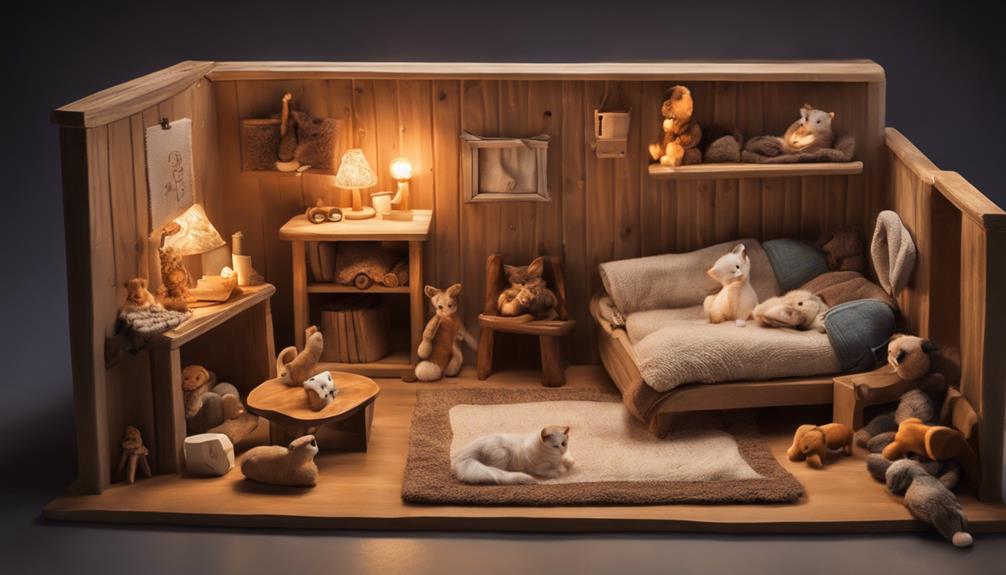
To establish a soothing environment for an overstimulated cat, provide a quiet, dimly lit space where the cat can retreat when overwhelmed. Ensuring a safe haven for your pet to relax and destress is crucial. Here are some tips to help you achieve this:
- Remove stressors: Identify and eliminate any triggers that could be causing your cat distress.
- Offer comfortable bedding: Providing a cozy and familiar spot for your cat to rest can help them feel secure.
- Allow alone time: Give your cat the opportunity to have some quiet moments to unwind and calm down.
Redirecting Excess Energy

To help an overstimulated cat channel its excess energy, engaging in interactive play sessions is a beneficial strategy. When your cat is experiencing sensory overload or overstimulation, redirecting their energy through play can be highly effective.
Interactive play sessions not only provide mental stimulation but also engage your cat's mind and body, helping them release pent-up energy in a positive way. Pet your cat gently while encouraging them to play with toys or engage in activities that capture their interest.
Incorporating puzzle-solving activities or toys can further redirect your cat's energy and reduce overstimulation. Offering scratching posts or toys specifically designed to stimulate your cat mentally can also be helpful.
Additionally, creating a calm and quiet environment can aid in redirecting your cat's energy towards more calming activities. Remember, providing enriching activities like food puzzles or treat-dispensing toys can keep your cat engaged while promoting a sense of relaxation and well-being.
Implementing Calming Techniques
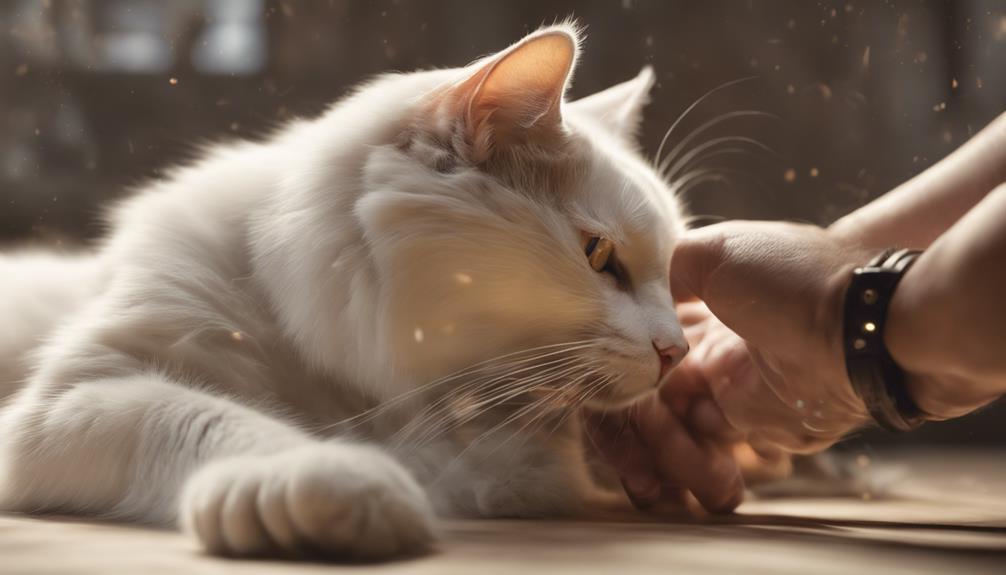
Let's explore practical ways to help an overstimulated cat relax and find peace through calming techniques. When it comes to calming an overstimulated cat, there are several effective strategies you can implement:
- End Play Sessions Promptly: Ensuring play sessions per day are kept short and sweet can prevent your cat from becoming overstimulated.
- Provide a Relaxing Environment: Creating a quiet, dimly lit space for your cat can help reduce stress and anxiety levels.
- Monitor Behavior Closely: Being vigilant for signs of overstimulation allows you to intervene early and implement calming techniques promptly.
Providing Mental Stimulation

Engaging in various interactive activities can provide essential mental stimulation for cats and keep them entertained. Cats thrive on play behavior, and offering a variety of interactive toys like feather wands, laser pointers, and puzzle feeders can help keep their minds engaged. Observing cat body language during playtime can also give insights into their preferences and level of stimulation. To prevent essential stimulation, it's vital to rotate toys regularly and introduce new ones to keep things fresh and exciting for your feline friend. Consider incorporating clicker training, hide-and-seek games, or scent-based challenges to further stimulate your cat's mind.
For a more hands-on approach, DIY cat enrichment activities such as cardboard boxes, paper bags, and homemade puzzle toys can provide mental stimulation while strengthening your bond with your pet. By paying attention to your cat's responses and adjusting activities accordingly, you can create a stimulating environment that keeps them happy and mentally sharp.
Frequently Asked Questions
How Do You Calm Down a Hyper Cat?
We calm down hyper cats by engaging in interactive play, providing a quiet environment, using calming techniques like petting, offering high-protein snacks, and considering calming products like pheromone sprays. These methods help cats relax and unwind.
Why Does My Cat Get Overstimulated so Quickly?
Comprehending why cats get overstimulated quickly. Factors like sensory sensitivity, predator instincts during play, pain, or social thresholds contribute. Recognizing these triggers helps manage our feline friends' stimulation levels effectively, ensuring their well-being.
What Is Sensory Overload in Cats?
We experience sensory overload in cats when they're overwhelmed by excessive stimuli, leading to erratic behavior. Triggers like loud noises or crowded spaces can cause distress, shown through dilated pupils or aggressive acts. Understanding this is essential for their well-being.
What Can I Give My Cat to Calm Him Down?
To calm your cat down, consider using calming treats or supplements like catnip. Pheromone sprays can create a soothing environment. Provide a quiet space for relaxation. Engage in interactive play. Stick to routines for consistency.
Conclusion
To sum up, identifying the signs of an overstimulated cat and establishing a secure environment are vital steps to help your furry friend relax.
By redirecting excess energy, implementing soothing techniques, and providing mental stimulation, you can effectively calm your cat and guarantee their well-being.
Remember, a happy and content cat leads to a happy and content owner. So, take the time to understand your cat's needs and create a peaceful environment for them to thrive.
Paul’s love for animals knows no bounds. As a dedicated writer and animal lover, Paul brings a unique perspective to our team. His firsthand experiences with various animals enrich our content and provide valuable insights into their behavior and needs. Whether he’s sharing tips for pet care or shedding light on pressing conservation issues, Paul’s passion for animals shines through in everything he does.
Cats
All-White Cat Breeds Unveiled
Discover the allure of all-white cat breeds and uncover the unique traits that make them so special. Keep reading to learn more about these elegant felines.
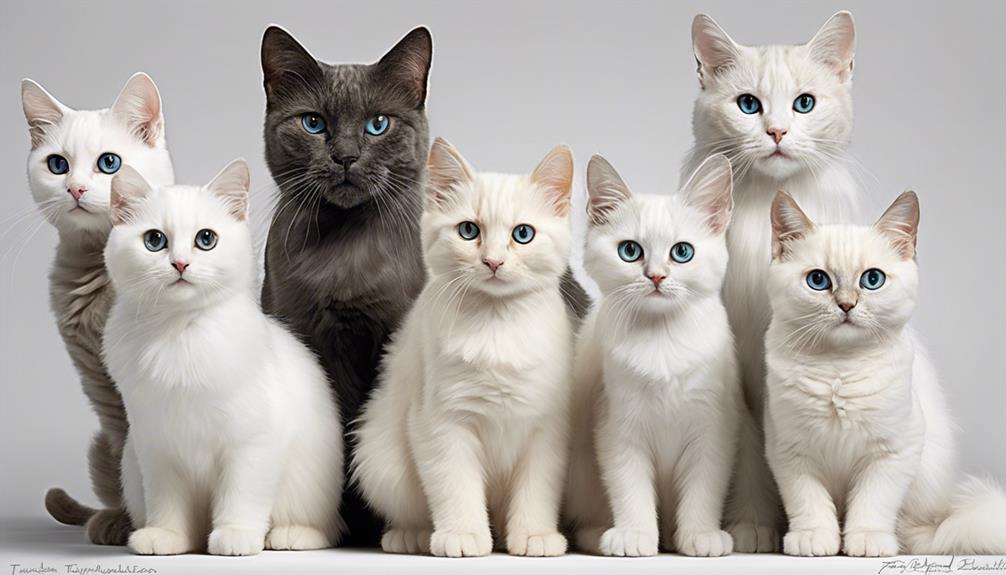
White cat breeds like the White Persian, White Siamese, and Russian White are elegant and charming choices for households. The White Persian needs daily brushing for a regal appearance, while the White Siamese is known for unique coat patterns. Ragdoll cats, though not all-white, are gentle and affectionate pets. The Russian White stands out with its all-white coat and affectionate nature. How rare are all-white cats? The solid white Khao Manee from Thailand is special. White cats symbolize purity and grace, but also have health considerations. Interested in rare and special white cats? Stay tuned for more unique information.
Key Takeaways
- White Persian cats require daily brushing for an elegant appearance.
- Russian White cats stand out with their elegant all-white coats.
- White Siamese cats are known for their unique coat patterns and striking blue eyes.
- Rare all-white cats are a result of genetic mutations for a pure white coat.
- Khao Manee cats from Thailand are pure white with yellow eyes symbolizing good luck.
White Persian
White Persians, with their short smushy faces and long, fluffy hair, require daily brushing to maintain their elegant appearance. This grooming routine not only keeps their coats luxurious but also prevents any uncomfortable mats from forming.
Their regal aura is accentuated by the pristine white color of their fur, making them a sight to behold. These felines aren't just about looks; their pleasant and placid nature makes them ideal housecats. White Persians are known for their affectionate demeanor, enjoying lounging around the house with their human companions.
If you're seeking a majestic and elegant feline friend, the White Persian is a popular choice. Their graceful presence and loving personality make them a delightful addition to any household. So, if you're ready to welcome a sophisticated and charming cat into your life, the White Persian might just be the perfect match for you.
White Siamese

White Siamese cats are known for their unique coat patterns, with some showcasing a charming ombre effect on their extremities.
Health considerations are important for this breed, as they can be prone to certain genetic conditions that owners should be aware of.
When it comes to temperament and behavior, White Siamese cats are highly sociable and energetic, making them engaging companions for both family members and strangers alike.
Unique Coat Patterns
With their striking blue eyes and sleek bodies, White Siamese cats boast unique coat patterns that set them apart from other breeds. Here are some fascinating facts about their coat patterns:
- Some White Siamese cats may exhibit a fading ombre pattern, with their extremities tinted brown or black, adding an elegant touch to their overall appearance.
- The contrast between their white fur and the subtle hints of color on their ears, face, paws, and tail creates a visually stunning look that captivates many cat enthusiasts.
- These distinctive coat patterns contribute to the charm and individuality of White Siamese cats, making them stand out in a crowd of felines.
White Siamese cats truly embody beauty and elegance with their unique coat patterns.
Health Considerations
As we explore the health considerations for White Siamese cats, it's important to understand the unique traits and care requirements that contribute to their overall well-being. White Siamese cats, known for their striking appearance with dark points against a white coat, may require special attention due to potential health issues associated with their breed.
Their high energy levels and outgoing nature make interactive play and mental stimulation essential for their happiness. Some White Siamese cats may display extremities tinted brown or black in a fading ombre pattern, adding to their charm.
Regular vet check-ups, a balanced diet, and ample exercise are essential for maintaining the health and vitality of these beloved feline companions. Taking these health considerations into account will help guarantee a long and fulfilling life for your White Siamese cat.
Temperament and Behavior
Known for their outgoing and affectionate nature, White Siamese cats exhibit a sociable temperament that delights their human companions. When considering a White Siamese as a furry friend, here are some key traits to expect:
- Outgoing: White Siamese cats aren't shy about seeking attention and interaction. They enjoy being in the center of activity and engaging with their human family members.
- Affectionate: These felines are known for their loving nature. They often show their affection through cuddles, headbutts, and purring, making them wonderful companions.
- Vocal: White Siamese cats are highly communicative through their distinctive meows. They use their voices to express their needs, emotions, and desires, creating a unique form of interaction with their owners.
Ragdoll Cats
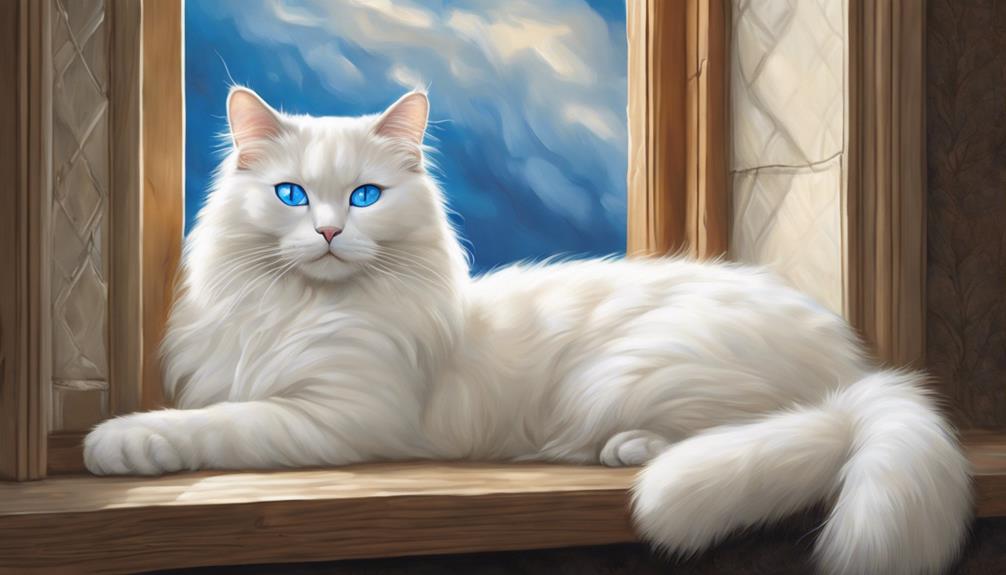
Ragdoll cats are cherished for their gentle and docile nature, making them wonderful companions for families. Their unique trait of going limp when picked up adds to their charm and endears them to many cat lovers.
When caring for a Ragdoll cat, it's important to provide regular grooming, interactive playtime, and a loving environment to guarantee their well-being.
Ragdoll Characteristics
With their unique tendency to relax when lifted, Ragdoll cats exhibit a distinct and endearing trait that sets them apart from other breeds. When considering Ragdoll characteristics, it's important to note:
- Color Variations: Ragdolls come in a range of colors, not just white, despite the common association with this hue.
- Temperament: Known for their gentle and affectionate nature, Ragdoll cats are ideal companions for families seeking a loving feline friend.
- Indoor Suitability: Their quiet and obedient demeanor makes Ragdolls well-suited for indoor living, providing comfort and companionship to their human family members.
Ragdolls truly stand out not only for their physical beauty but also for their delightful personalities, making them a popular choice for households seeking a gentle and loving cat.
Ragdoll Care Tips
How can we guarantee that Ragdoll cats maintain their beautiful fur and gentle nature? Ragdolls are known for their calm demeanor and low-maintenance grooming needs. Regularly brushing their semi-long fur is key to preventing matting and keeping their coat pristine. These gentle felines thrive on affection and are excellent companions for families, especially with children. To help you care for your Ragdoll effectively, we've compiled a simple guide below:
| Care Tips | Description |
|---|---|
| Grooming | Brush your Ragdoll's fur regularly to prevent matting. |
| Affectionate Nature | Provide plenty of love and attention to keep them happy. |
| Playtime | Engage them in interactive play sessions for mental stimulation. |
| Regular Vet Visits | Schedule check-ups to guarantee their health and well-being. |
Ragdoll Personality Traits
To understand the charm of Ragdoll cats, their endearing personality traits offer a delightful glimpse into their enchanting nature.
- Gentle Demeanor: Ragdoll cats are known for their quiet, obedient nature and their tendency to go limp when lifted, making them easy to manage and handle due to their calm and placid demeanor.
- Playful Behavior: Despite their gentle disposition, Ragdolls can surprise you with their bursts of playful and energetic behavior, adding a fun and lively aspect to their personality.
- Versatile Colors: While Ragdolls are often associated with white, they actually come in various colors, contributing to their versatility and making them even more visually appealing as companions in many households.
Russian White
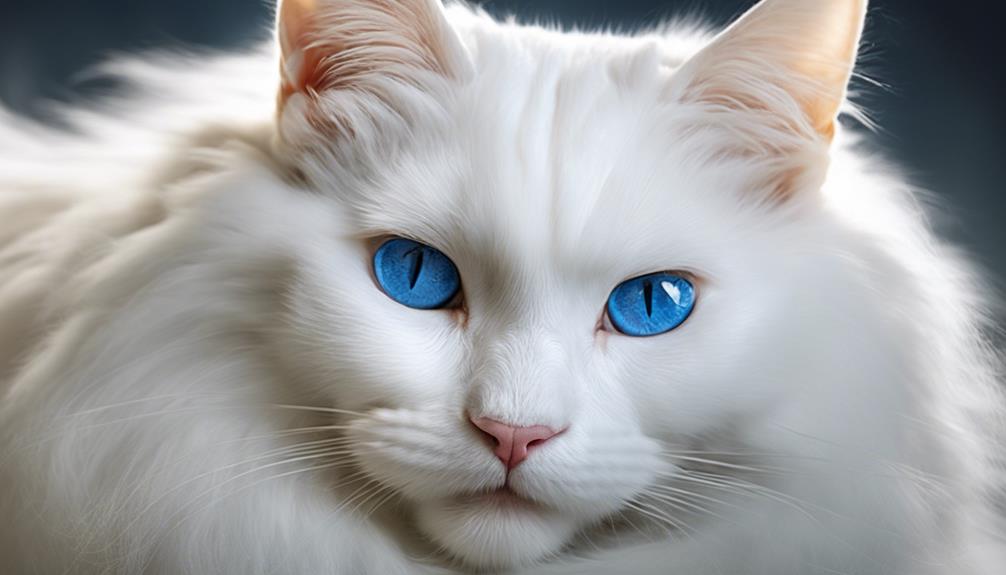
Undoubtedly, Russian White cats stand out for their elegant all-white coat and gentle demeanor, making them sought-after companions for families. Originating from a mix of non-pedigree domestic Siberian cats and pedigree Russian Blue cats, these felines boast a rich heritage despite their name suggesting otherwise. Hailing from Australia, Russian White cats are a relatively rare breed prized for their striking appearance and affectionate nature.
One of the most remarkable features of Russian White cats is their pristine all-white coat that exudes elegance and grace. Coupled with their gentle and affectionate temperament, these cats make wonderful additions to households seeking a loving companion. Their striking green or blue eyes beautifully complement their white fur, adding to their charm and appeal. Whether they're lounging gracefully or engaging in playful antics, Russian White cats are sure to enchant the hearts of those around them with their captivating presence.
Balinese Cats

Russian White cats, known for their elegant all-white coat and gentle demeanor, lead us to explore the intriguing world of Balinese Cats. As descendants of Siamese cats, Balinese cats boast a distinctive angular appearance that sets them apart from other breeds.
To dive deeper into their enchanting characteristics, consider the following:
- High-Energy Felines: Balinese cats are described as feisty and high-energy companions, requiring ample exercise and interactive play to keep them mentally and physically stimulated.
- Sleek Elegance: With their sleek, elegant build and striking blue almond-shaped eyes, Balinese cats exude grace and beauty, fascinating all who encounter them.
- Affectionate and Social: Known for their affectionate nature, Balinese cats thrive on human interaction and enjoy being the center of attention. Their social demeanor makes them wonderful companions for those seeking a loving feline friend.
With their striking appearance and engaging personalities, Balinese cats make a delightful addition to any household willing to provide them with the care and attention they deserve.
Himalayan Cats
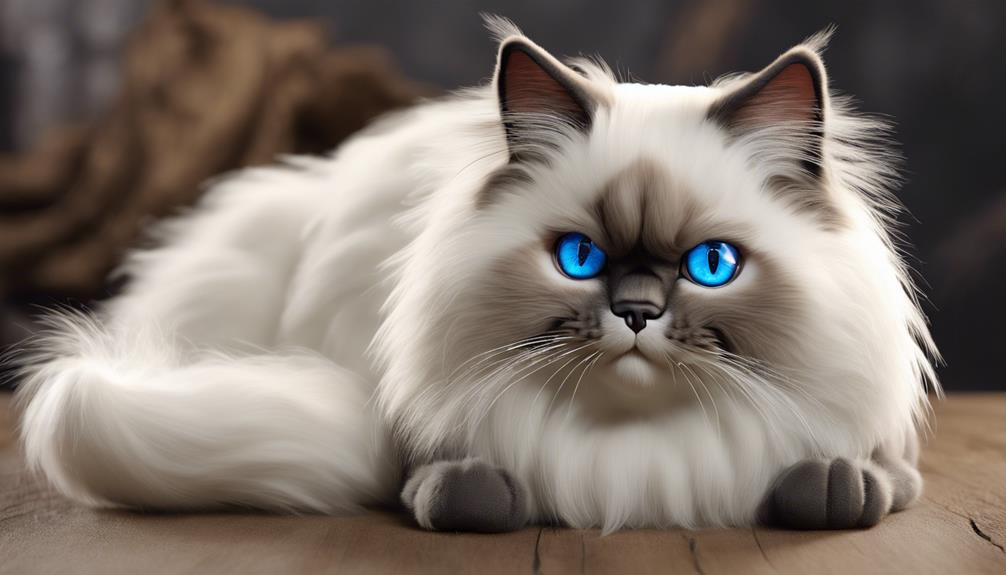
Himalayan cats boast a unique colorpoint coat pattern, featuring a white body with distinct color points on their ears, face, paws, and tail.
Known for their affectionate nature, Himalayans are social creatures that thrive on human companionship.
Regular grooming is essential to maintaining their luxurious fur and preventing mats, ensuring they stay happy and healthy.
Colorpoint Coat Pattern
With a striking colorpoint coat pattern, Himalayan cats exhibit darker coloring on their ears, face, paws, and tail, creating a visually alluring and elegant appearance. This unique feature is a result of a temperature-sensitive gene that produces color only on cooler parts of the body.
Here's why Himalayan cats stand out:
- Crossbreed Origins: Himalayan cats are a delightful mix of Siamese and Persian cats, inheriting the colorpoint pattern from the Siamese breed.
- Luxurious Fur: Their luxurious long fur adds to their regal appearance, making them a popular choice among cat lovers.
- Blue-Eyed Beauty: Combined with their striking blue eyes, the colorpoint coat pattern enhances the elegance and charm of Himalayan cats.
Affectionate and Social
Known for their affectionate nature and love for human companionship, Himalayan cats are cherished for their striking blue eyes and luxurious long coat. These cats thrive on being social and forming strong bonds with their owners. They enjoy cuddling and being petted, making them ideal companions for those seeking a loving feline friend.
Himalayan cats aren't only beautiful but also have a gentle temperament that makes them great family pets. Regular interaction and playtime are essential for keeping them happy and emotionally fulfilled. Whether lounging on your lap or following you around the house, Himalayan cats will shower you with affection and companionship, creating a special bond that will warm your heart.
Cornish Rex
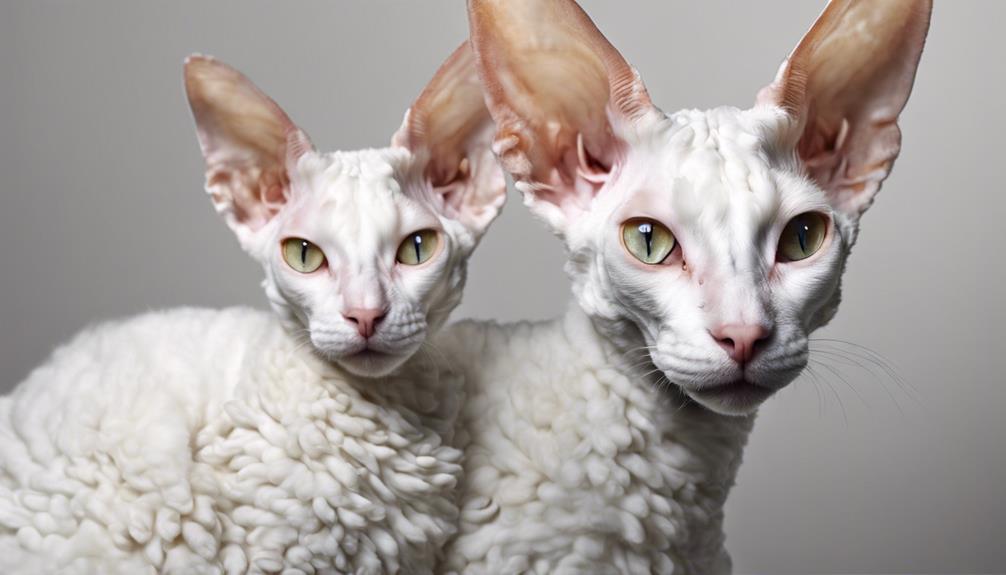
Originating from the United Kingdom, the Cornish Rex cat is renowned for its unique curly coat and distinctive appearance. When it comes to shorthair cats, the Cornish Rex stands out for several reasons:
- Curly Coat: Unlike other breeds, the Cornish Rex has a coat that's soft, wavy, and curly, giving them a distinct look that sets them apart from other cats. This curly coat is a result of a genetic mutation, making them quite unique in the feline world.
- Elegant Appearance: With their slender bodies, large ears, and striking eyes, Cornish Rex cats have an elegant and graceful appearance that captivates many cat lovers. Their fine boning and arched backs add to their allure, making them a popular choice for those seeking a cat with a sophisticated look.
- Playful Nature: Beyond their physical characteristics, Cornish Rex cats are known for their playful and affectionate personalities. They enjoy interactive play and are often described as energetic and intelligent companions, making them a delightful addition to any household.
Unique and Cool Cat Breeds

Let's explore some of the most fascinating cat breeds that stand out for their unique characteristics and cool appeal.
While white cat breeds like the Ukrainian Levkoy and albino cats are striking in their own right, there are several other breeds with distinctive features worth mentioning.
Sphynx cats, known for their lack of coat, come in various solid colors or patches, adding to their charm. The Cornish Rex's downy undercoat sets them apart, giving them a soft and wavy appearance that's truly enchanting.
Scottish Fold cats, with their iconic curled ears, have a controversial yet undeniably stylish appeal among cat enthusiasts. Finally, LaPerm cats boast curly fur and a tousled look, making them a unique and interesting breed to contemplate.
These breeds showcase the diversity not only in coat colors but also in physical characteristics, making them stand out in the world of feline companions.
Hairless
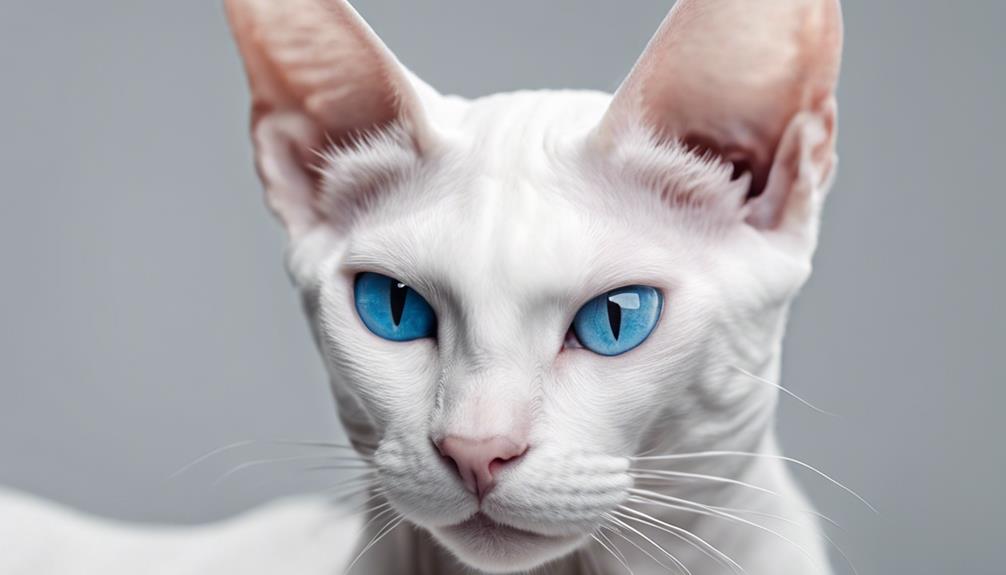
Exploring unique cat breeds with distinctive features that set them apart, hairless cats like the Ukrainian Levkoy and Sphynx breeds showcase minimal to no fur and may exhibit special physical traits such as curled ears. These breeds offer a striking appearance and a soft, warm skin texture that many find endearing. Here are some fascinating facts about hairless cats:
- Ukrainian Levkoy: This breed is known for its angular appearance, with a slender body and distinctive folded ears. Their lack of fur accentuates their sleek physique, making them stand out in the feline world.
- Sphynx Breeds: Sphynx cats are one of the most popular hairless breeds, known for their friendly and outgoing personalities. Despite their lack of fur, they're surprisingly warm to the touch and often seek out cozy spots for comfort.
- Cornish Rex: While not completely hairless, the Cornish Rex breed has a unique coat that's short, soft, and curly. Their velvety fur sets them apart from other hairless breeds, giving them a distinct and elegant appearance.
Controversial

Amid the diverse world of cat breeds, certain feline varieties spark controversy due to their unique physical characteristics and genetic traits. Scottish Folds, known for their adorable folded ears, have been at the center of debate due to the potential health issues associated with this trait.
Munchkin cats, with their endearing short legs resulting from achondroplasia, often divide opinions among cat enthusiasts. Exotic Shorthair cats, although not as controversial, offer a manageable coat similar to Persians but with a more practical upkeep. LaPerm cats stand out with their distinctive curly fur, making them a topic of interest in the cat community.
These breeds elicit strong reactions from individuals passionate about feline companions. While some admire the distinctive features that set these cats apart, others express concerns about the potential health implications or breeding practices. Understanding the controversies surrounding these breeds can help potential cat owners make informed decisions based on their preferences and values.
Only Marginally Weird

Exotic Shorthairs, with their short fur and smushed-in faces, add a unique flair to the world of white cat breeds. These cats aren't just your ordinary feline companions; they bring a touch of the exotic to the mix, making them stand out in a crowd of fluffy friends. What makes them only marginally weird are their unmistakable features that blend seamlessly into their overall charm.
Here are some unique features of white cat breeds that make them intriguing but not overly strange:
- Bengals and Savannahs sport an exotic appearance with their striking spotted patterns, setting them apart from the traditional solid white coats seen in other breeds.
- LaPerm cats boast curly fur and a tousled appearance, adding a touch of whimsy to the white cat family without crossing into the domain of eccentricity.
- Scottish Fold cats, with their controversial characteristics like ears that curl inward, bring a hint of intrigue to the mix, making them fascinating yet not too outlandish.
These white cat breeds offer a delightful blend of uniqueness and familiarity, making them a charming addition to any cat lover's home.
How Rare Is an All-White Cat?
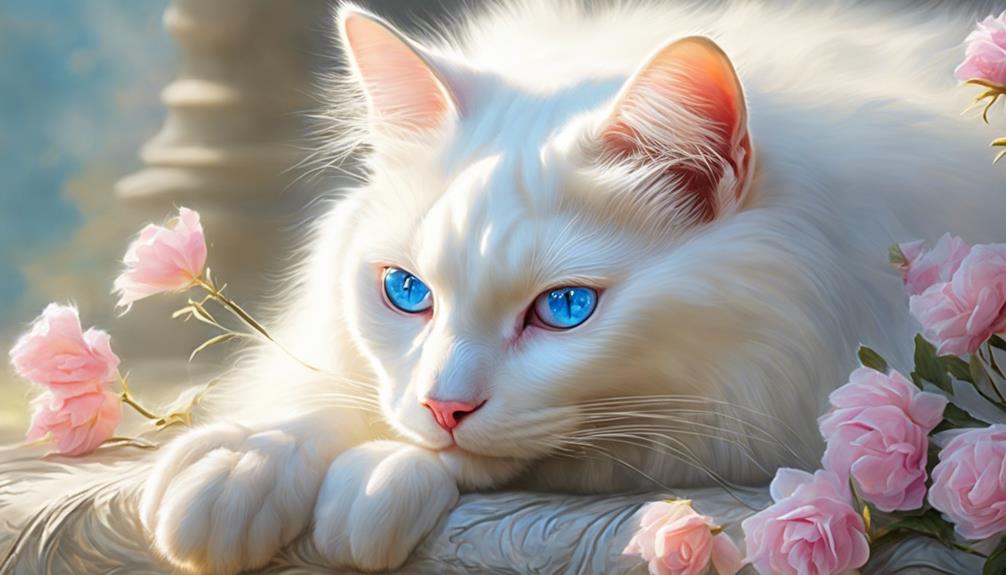
All-white cats are considered a rarity in the feline world due to their distinctive lack of markings or color patches on their fur. This pure white coat is often a result of a genetic mutation that leads to a lack of melanin production, giving these cats their unique appearance. While some white cats may be albino, characterized by a genetic condition affecting their skin, fur, and eye color, most white cats aren't albino but rather have a pure white coat.
The scarcity of all-white cats adds to their charm and allure, making them stand out among other feline companions. Their striking appearance, coupled with their elegant white fur, captures the hearts of many cat lovers. It's worth mentioning that white cats with blue eyes may be more prone to deafness due to genetic factors, adding another layer of uniqueness to these already rare felines. So, if you're lucky enough to share your home with an all-white cat, cherish their beauty and uniqueness.
What Is the Rarest Cat Color?
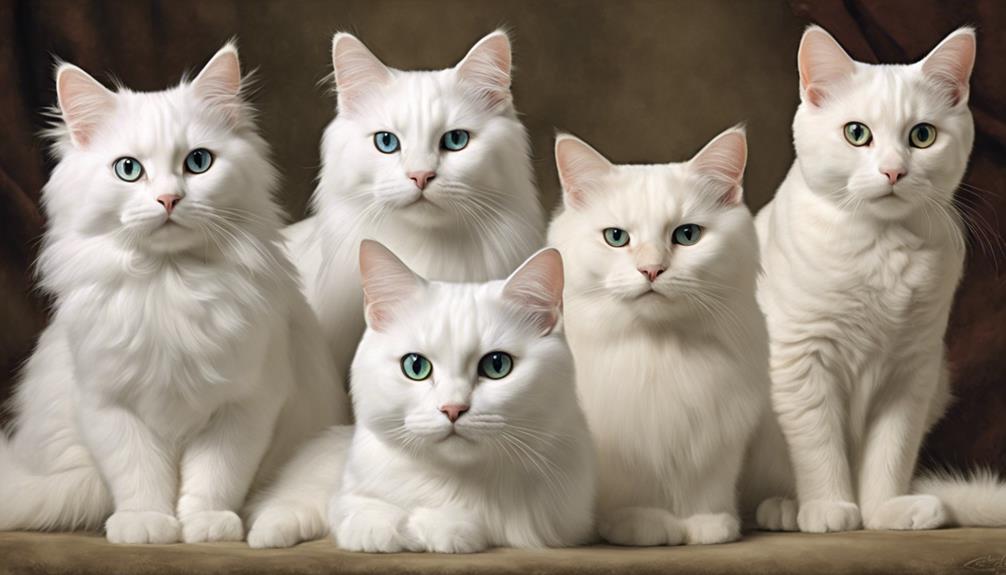
The rarest cat color is solid white, a result of specific genetic mutations that give these felines their unique and striking appearance. White cats with pink skin and blue eyes due to albinism are exceptionally rare, adding to the allure of their snow-white coats. Some white cats have unique genetic variations that result in white fur without albinism, making them stand out even more among their colorful counterparts. Albino cats face health risks like sunburn and vision problems due to their lack of melanin, highlighting the importance of proper care for these special felines.
In the world of cats, solid white coats are like precious treasures, catching the eye and sparking interest. These majestic creatures, with their pure white fur and enchanting presence, are a reflection of the fascinating intricacies of genetic diversity in the feline world. Whether they prance around the house or lounge in the sun, solid white cats are truly a sight to behold, embodying elegance and grace in every whisker.
Pure White Cat With Yellow Eyes
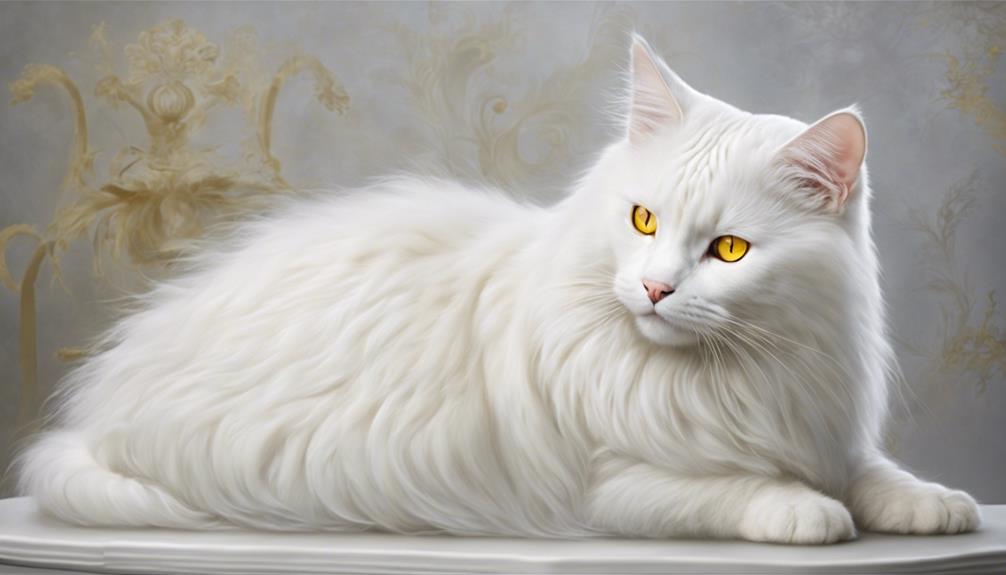
With their pure white coats and striking yellow eyes, Khao Manee cats are renowned for their distinctive appearance. Originating from Thailand, these elegant felines fascinate with their beauty and charm. The contrast between their pristine white fur and vibrant yellow eyes creates a mesmerizing allure that's hard to resist.
Khao Manee cats aren't only visually stunning but also known for their friendly and affectionate nature. Their enchanting gaze, accentuated by those striking yellow eyes, adds to their allure, making them a sought-after breed among cat enthusiasts. In some rare cases, Khao Manee cats may exhibit odd eyes, where each eye is a different color, further enhancing their unique appeal.
These pure white cats with yellow eyes aren't only beautiful but also hold a special place in the hearts of those who admire them. Originating from Thailand, these regal creatures have a rich history and are considered a symbol of good luck and prosperity in their homeland.
Why Are White Cats Special?

White cats have a unique charm due to their symbolic representations of purity and grace. Genetic factors play an essential role in determining the stunning white fur that sets them apart.
Understanding these genetic variations sheds light on misconceptions about white-coated felines.
White Cats Uniqueness
Symbolizing purity and grace in various cultures, white cats captivate with their pristine coats. These feline beauties stand out not only for their stunning white fur but also for their mesmerizing blue eyes, a feature often linked to genetic variations. Understanding these genetic factors helps debunk misconceptions about white cats, dispelling the myth that they're all albino.
Additionally, white cats hold special cultural significance, being seen as symbols of good luck in traditions like Japanese folklore. Their uniqueness goes beyond appearance; health considerations such as potential deafness and skin sensitivity require specific care and attention to make certain their well-being. Embracing these unique traits allows us to appreciate and care for these special companions better.
Genetic Factors in White Fur
Enchanting with their immaculate coats and spellbinding blue eyes, white cats owe their unique appearance to specific genetic mutations that suppress pigment production, particularly influenced by the KIT gene responsible for coat color in felines.
These genetic factors not only give white cats their stunning white fur but also contribute to other distinctive features, such as their mesmerizing blue eyes. The KIT gene, significant in determining coat color, plays a vital role in producing the beautiful white fur that sets these cats apart.
Additionally, the genetic associations linked to white fur can sometimes result in mesmerizing blue or even heterochromatic eyes. Understanding these genetic underpinnings sheds light on the allure and special traits of white cats, making them even more fascinating and cherished companions.
Frequently Asked Questions
What Breed of Cat Is Usually All White?
We adore cats like the Khao Manee, Turkish Angora, Russian White, White Persians, and Siamese for their stunning all-white coats. These breeds often showcase pure white fur, enthralling us with their beauty and grace.
How Rare Is a Completely White Cat?
Completely white cats are extremely rare due to the specific genetic combination required for a pure white coat. Inheriting the white coat gene from both parents is essential. White cats with blue eyes, like Khao Manee, are striking.
What Is the Rarest Color of Cat?
The rarest color of cat is solid white. It's associated with purity and grace, making white cats exceptionally rare. Their striking appearance, especially breeds like Khao Manee with blue or odd-colored eyes, stands out among feline colors.
How Much Do Pure White Cats Cost?
Pure white cats can range from $500 to $3,000 depending on breed and breeder. Adoption fees typically range from $50 to $150, inclusive of vaccinations. Show-quality cats with pedigrees can cost considerably more, adding grooming and healthcare expenses.
Conclusion
To sum up, all-white cat breeds like the White Persian, White Siamese, Ragdoll Cats, Russian White, and Balinese Cats aren't only beautiful but also unique in their own way.
While some may argue that white cats are more prone to deafness, their stunning appearance and loving personalities make them special companions.
So, if you're considering adding an all-white cat to your family, rest assured that you'll be welcoming a truly one-of-a-kind feline friend into your home.
Paul’s love for animals knows no bounds. As a dedicated writer and animal lover, Paul brings a unique perspective to our team. His firsthand experiences with various animals enrich our content and provide valuable insights into their behavior and needs. Whether he’s sharing tips for pet care or shedding light on pressing conservation issues, Paul’s passion for animals shines through in everything he does.
Cats
How Long Do Cat Pheromones Last?
A deep dive into the duration of cat pheromones and the surprising differences between natural and synthetic options.
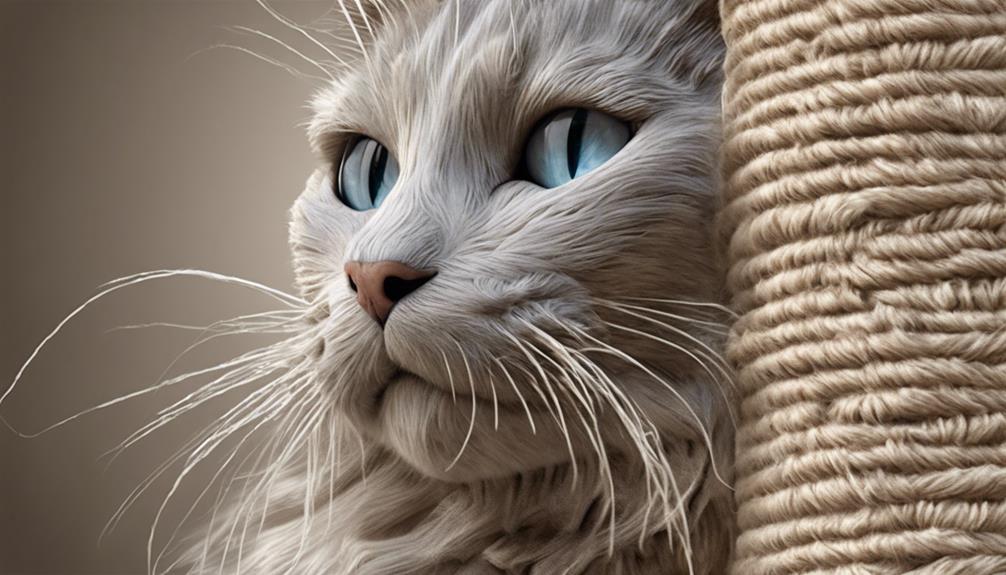
Cat pheromones can naturally last up to three days. However, synthetic pheromone sprays, like those for calming effects, usually need reapplication every 4-5 hours. Keeping a consistent environment is key for happy cats. Understanding these differences helps in finding the best product for your furry friend.
Key Takeaways
- Natural cat pheromones last up to three days.
- Synthetic pheromone sprays last around 4-5 hours.
- Diffusers release pheromones continuously for a month.
- Duration varies based on product and cat's response.
- Consistent use ensures a calming environment.
Overview of Cat Pheromones
When evaluating cat behavior, understanding the basics of cat pheromones becomes essential. Cat pheromones aren't just scents; they're powerful tools used by cats to mark territory and engage in social communication. These invisible signals can last up to three days when naturally deposited, influencing behaviors and interactions. However, synthetic pheromone sprays, often used for calming effects, typically need reapplication every 4-5 hours due to their shorter lifespan.
The longevity of cat pheromones plays an important role in maintaining harmony in a cat's environment. By comprehending how these pheromones work and their effects on behavior, we can create a more suitable living space for our feline friends. Environmental factors such as stress, changes in routine, or new additions to the household can impact the duration and efficacy of these pheromones. Being mindful of these elements is essential for ensuring a positive and comfortable atmosphere for our beloved cats.
Types of Cat Pheromones
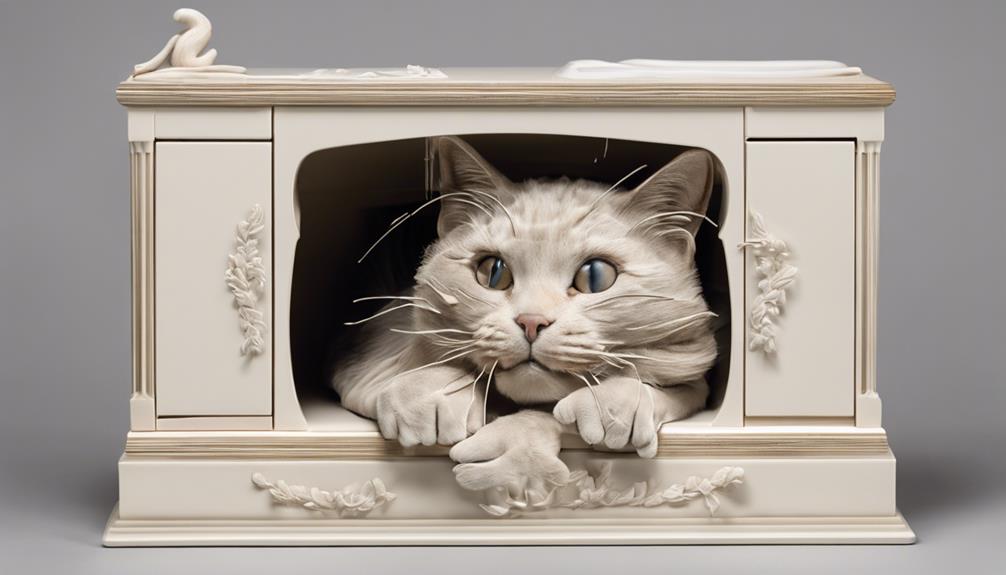
Some common cat pheromones, like F3, F4, and Feliway, help cats mark territory and promote social interactions.
These pheromones play an essential role in regulating feline behavior and social dynamics.
Understanding the effects of different types of cat pheromones can provide insights into how they influence cat behavior in various situations.
Common Cat Pheromones
Common cat pheromones play an essential role in feline communication and behavior. Facial pheromones help cats orient themselves and mark territory, lasting up to 3 days.
Cat-appeasing pheromones aid in maternal bonding, lasting around 4-5 hours when artificially applied.
Interdigital semiochemicals, vital for social interactions, may last up to 5 hours post-application.
Male cat pheromones, used for territorial marking and mating, can naturally linger for up to 3 days.
Understanding the duration of these specific pheromones guides the timing of reapplication for desired effects. These pheromones are key in the intricate language of cats, influencing their interactions and behaviors in various ways.
Effects on Behavior
Facial pheromones play an important role in feline communication and behavior, influencing how cats orient themselves in their environment and marking their territory.
Feline facial pheromones like F3 help cats establish their territory and feel secure in their surroundings.
The Feline appeasing pheromone, produced by mammary glands, fosters maternal bonding and guarantees peaceful interactions within the litter.
Additionally, the allomarking pheromone F4 aids in social interactions among cats, facilitating smoother communication between them.
Understanding the functions of these different cat pheromones can greatly enhance the quality of interactions and relationships between cats, making for a more harmonious and balanced environment for our feline friends.
Functions of Cat Pheromones
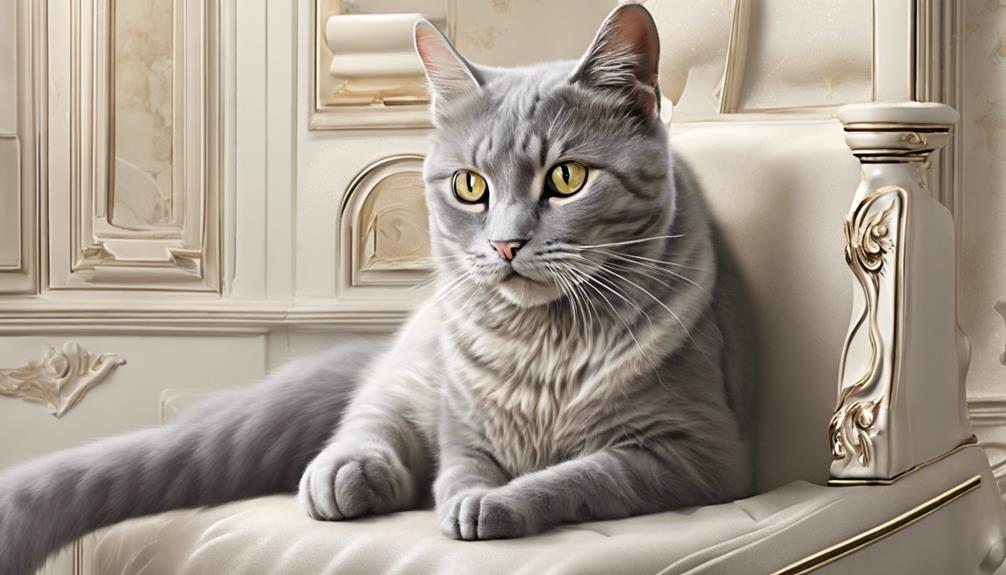
Cat pheromones serve essential functions in the social interactions and communication of felines. These natural chemical signals play an important role in:
- Marking Territory: Cats use pheromones to mark their territory, signaling to other cats about their presence and ownership of a particular space.
- Attracting Mates: Pheromones help cats attract potential mates by signaling their availability and reproductive status.
- Calming Kittens: Mother cats release pheromones to soothe and comfort their kittens, creating a sense of security and well-being.
- Bonding with Other Cats: Pheromones facilitate social bonding among cats, helping them establish and maintain harmonious relationships with other feline companions.
Understanding these functions of cat pheromones is crucial for fostering healthy social behavior and reducing stress in our beloved feline friends.
Importance of Cat Pheromones
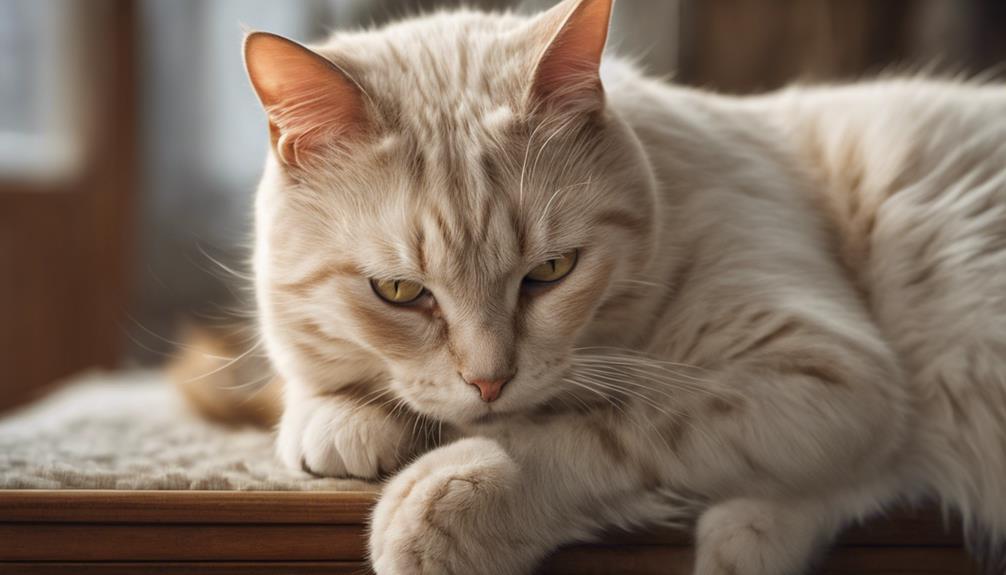
Understanding the significance of feline pheromones is vital for enhancing our comprehension of cats' social behaviors and emotional well-being. Cat pheromones play an essential role in shaping how our feline friends interact with each other and navigate their environment.
These chemical signals help in behavior modification by providing a sense of security and familiarity in various situations. By using synthetic pheromone sprays, we can replicate these natural signals to create a calming effect on cats, promoting their well-being and reducing stress levels.
Regular use of pheromone products guarantees a consistent impact on cats, assisting in their social interactions and emotional stability. By recognizing the importance of cat pheromones, we can better support our furry companions in feeling safe and secure in their surroundings, ultimately fostering a harmonious bond between cats and their human companions.
Duration of Cat Pheromone Effects
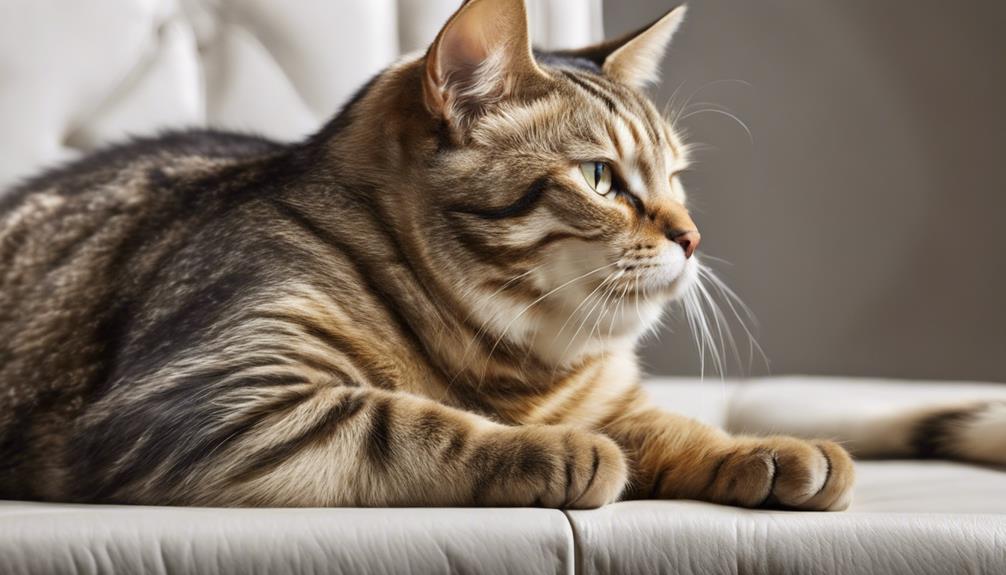
When contemplating the longevity of cat pheromone effects, it's crucial to comprehend the varying durations based on the type of product utilized and the individual cat's response. Here are some key points to ponder:
- Natural cat pheromones can last up to three days after being deposited by the cat.
- Artificial pheromone sprays typically necessitate reapplication every 4-5 hours for sustained effects.
- Pheromone diffusers provide continuous release over a month when plugged in 24/7.
- The duration of cat pheromone effects varies based on the product used and the individual cat's response.
Regular use of pheromone products is recommended to maintain a calming environment for cats. By understanding the duration of effects of different types of cat pheromones, cat owners can select the most suitable product for their feline companions.
Factors Affecting Pheromone Duration
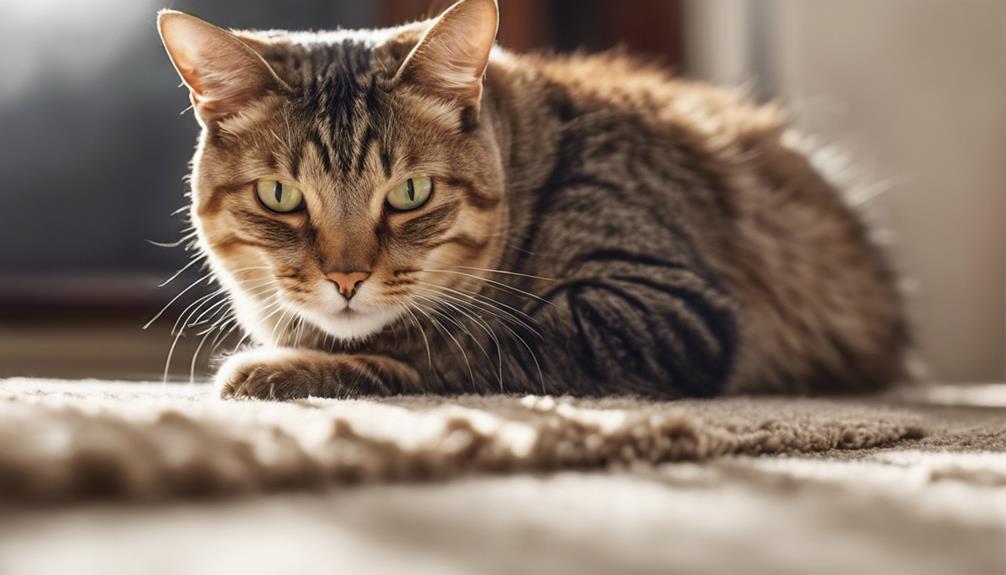
When considering the duration of cat pheromones, various factors come into play that influence their lasting effects.
Pheromone type variations, environmental factors like air circulation and temperature, as well as changes in cat behavior can all impact the longevity of pheromone efficacy.
Understanding these elements can help pet owners make informed decisions on how to best utilize pheromone products for their feline companions.
Pheromone Type Variations
In examining variations in pheromone types affecting duration, the environment plays a significant role in how long cat pheromones remain effective. Here are some key factors to bear in mind:
- Natural vs. Synthetic Pheromones: While natural cat pheromones can linger for up to three days, synthetic pheromone sprays may need reapplication every 4-5 hours for sustained effects.
- Environmental Influences: Factors like temperature and airflow can impact the duration of cat pheromones in the environment.
- Marking Behavior: Pheromones released through marking may persist longer in areas with less disturbance.
- Pheromone Diffusion: The way pheromones spread in the air can affect how long these signals remain potent for cat detection.
Understanding these variations can help in creating a conducive environment for your feline friend.
Environmental Factors Impact
Considering the impact of environmental factors on the duration of cat pheromones, it becomes evident that variables like temperature and airflow greatly influence the effectiveness of these chemical signals.
In ideal conditions, where disturbances are minimal, pheromones may linger for up to three days. However, high temperatures and ventilation can hasten their degradation, necessitating more frequent reapplication. Pheromones left on surfaces are prone to quicker breakdown compared to those diffused in the air.
Understanding these environmental factors is essential to optimize the longevity of cat pheromones and guarantee their efficacy. By controlling factors like temperature and airflow, cat owners can create an environment that maximizes the benefits of pheromone products for their feline companions.
Cat Behavior Changes
To better understand how cat behavior changes are influenced by factors affecting pheromone duration, we must analyze the interplay between environmental stimuli and feline responses.
- Cat Pheromones and Longevity: Natural cat pheromones typically last up to three days before dissipating, impacting how long their calming effects persist.
- Environmental Factors at Play: Temperature and airflow can influence the longevity of cat pheromones, affecting their effectiveness in managing behavior.
- Synthetic Products and Reapplication: Synthetic pheromone products may require reapplication every 4-5 hours for sustained effects, ensuring continuous support for your cat's well-being.
- Diffusion Rate Variability: Pheromone diffusion rates can vary based on the type of product used, highlighting the importance of choosing the right formulation for best results.
How Long FELIWAY Lasts
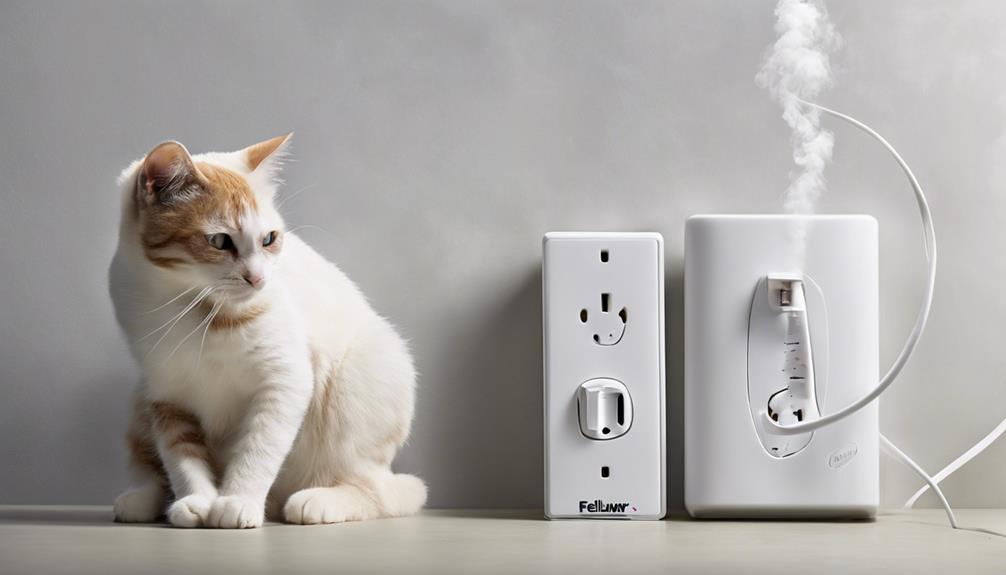
When utilizing FELIWAY Classic diffusers, the effects typically last for up to 30 days with continuous use. This means that by consistently plugging in the diffuser, you can help create a calming environment for your feline friend for an entire month.
On the other hand, if you opt for the FELIWAY Classic spray, the effects last for a shorter period, about 4-5 hours after application. For longer journeys or situations where your cat may need prolonged support, you might need to reapply the spray.
To guarantee best results, it's recommended to replace the FELIWAY Classic diffuser vial every 30 days. Remember, consistency is key when using FELIWAY products. To observe significant changes in your cat's behavior, it's best to use the products consistently for at least a month.
Prolonging Pheromone Effects

When it comes to prolonging the effects of cat pheromones, there are simple strategies that can help maintain their efficacy over time.
Regularly replacing pheromone diffusers after 30 days and reapplying sprays every 4-5 hours can guarantee a consistent release of pheromones.
Consistency in using pheromone products is essential for managing cat behavior effectively and maximizing the benefits of these calming signals.
Enhancing Pheromone Longevity
Enhancing the longevity of cat pheromones can be achieved through consistent use of pheromone diffusers. This method allows for continuous release of calming signals, maintaining a soothing environment for your feline friend.
To enhance pheromone longevity effectively, consider the following:
- Regularly use pheromone diffusers in areas where your cat spends the most time.
- Follow the manufacturer's instructions for best pheromone diffusion.
- Avoid relying solely on artificial pheromone sprays, as they may require frequent reapplication.
- Consistent use of pheromone products is key to ensuring a lasting calming effect on your cat.
Tips for Sustained Effects
To maximize the effectiveness of cat pheromones over an extended period, consistent application of pheromone products according to their recommended usage guidelines is crucial. Using synthetic pheromones from diffusers can provide lasting effects for up to 30 days, while pheromone sprays may require more frequent reapplication, typically every 4-5 hours, to maintain their calming benefits.
Pheromone collars offer a continuous release of calming signals for about a month, contributing to sustained effects on your feline friend. By incorporating these products into your cat's routine regularly, you can help guarantee a consistent and calming environment for your pet. This routine care can greatly support your cat in feeling secure and comfortable, enhancing their overall well-being.
Signs of Expired Pheromones
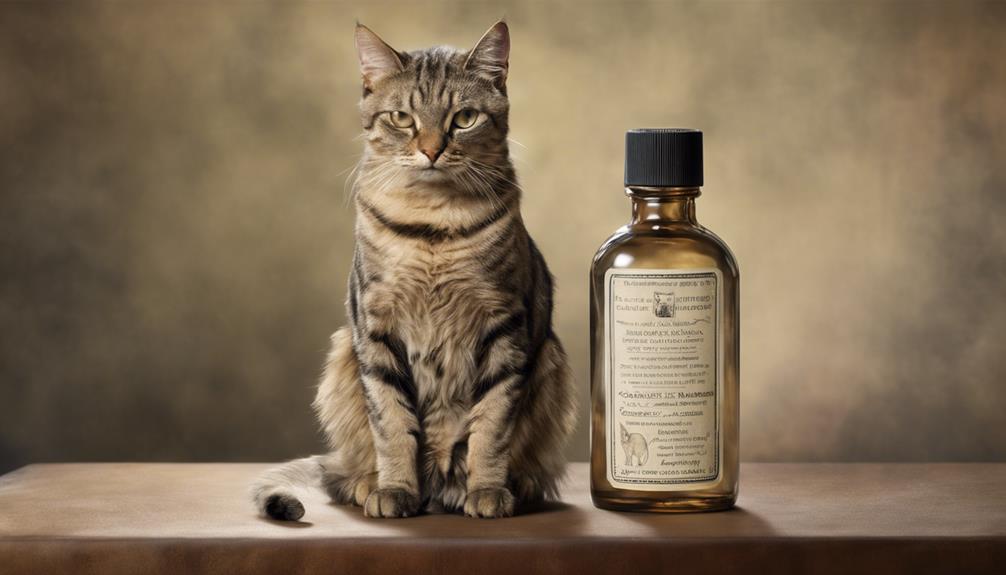
Experiencing increased stress or anxiety in cats could indicate signs of expired pheromones. When pheromones lose their efficacy, several noticeable changes may occur in your feline companions:
- Renewed Marking Behavior: Cats might start marking their territory more frequently, especially in areas they haven't marked before.
- Tension Between Cats: Increased conflicts and aggression among cats in a multi-cat household could signal the need to refresh the pheromones.
- Undesirable Behaviors: Look out for behaviors like excessive meowing, hiding, or destructive scratching, as these could be signs of expired pheromones affecting your cats' well-being.
- Environmental Changes and Stressful Events: Pheromones may lose their effectiveness quicker in response to changes in the environment or during times of stress, such as moving to a new house or introducing a new pet.
Replacing Pheromone Products
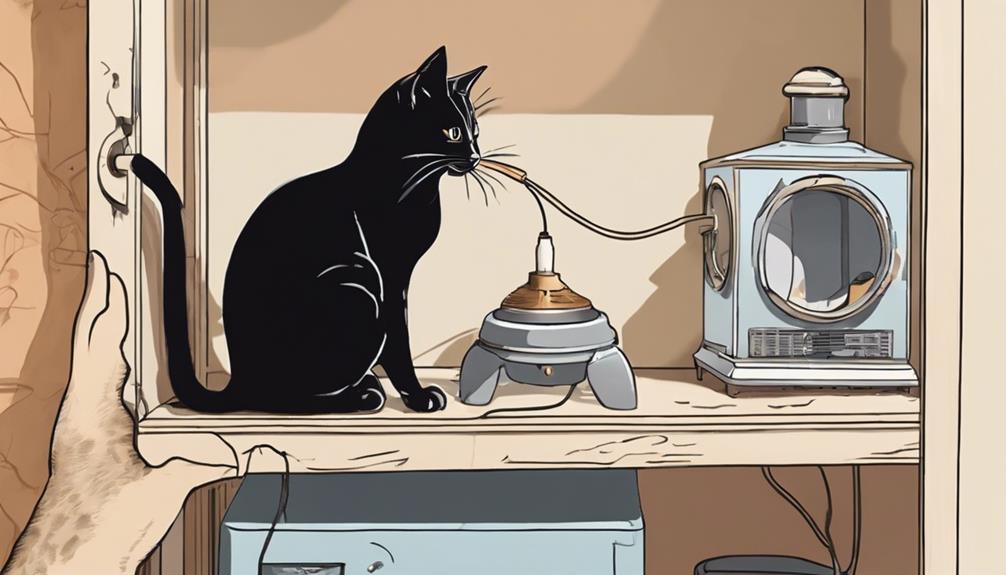
When it comes to ensuring the effectiveness of pheromone products for cats, regular replacement is crucial for maintaining their calming effects. Natural cat pheromones typically last up to three days, while artificial pheromone sprays may need reapplication every 4-5 hours to sustain their benefits.
For pheromone diffusers, it's essential to have their vials replaced every 30 days to guarantee a consistent release of calming signals. By staying on top of these replacements, you can guarantee that your cat continues to benefit from the pheromone products.
Consistent use is key in managing your cat's behavior and stress levels effectively. Remember, the longevity of cat pheromones depends on the type of product and how it's applied. So, keep an eye on the expiration dates and follow the recommended reapplication schedules to support your cat's well-being.
Extending Cat Comfort With Pheromones
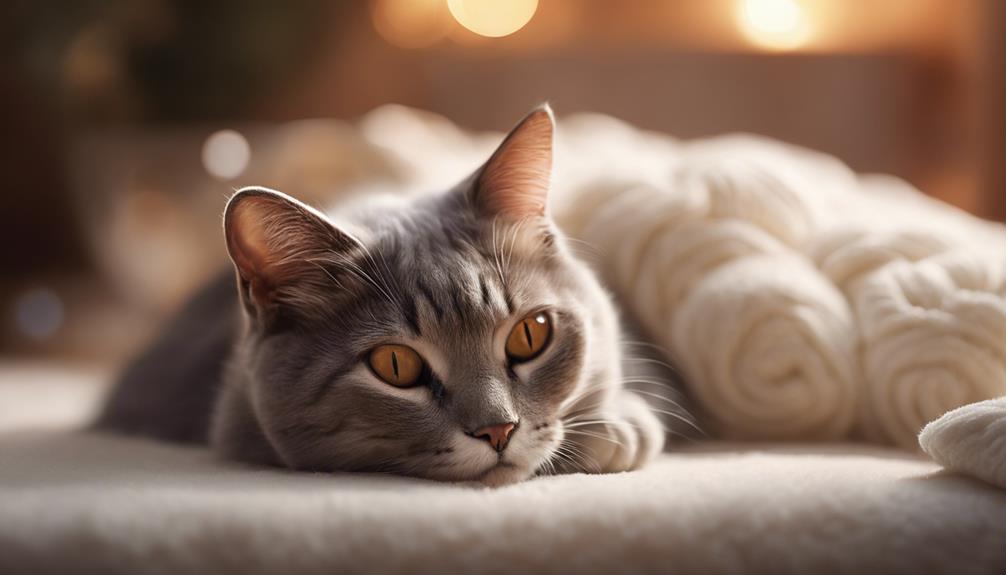
When it comes to extending your cat's comfort with pheromones, there are a few key points to ponder.
Pheromone diffusers offer a continuous release of calming signals, providing a long-lasting effect in your cat's environment.
Additionally, calming collars can be effective in promoting relaxation, while sprays offer quick relief in stressful situations.
Pheromone Diffuser Benefits
To enhance a cat's comfort and well-being, utilizing a pheromone diffuser that lasts approximately 30 days is beneficial. Here are some benefits of using a pheromone diffuser for your feline friend:
- Reducing Stress: Pheromone diffusers help in calming anxious cats, reducing stress levels over time.
- Promoting Relaxation: The steady release of pheromones from the diffuser creates a relaxing environment, aiding in your cat's relaxation.
- Creating a Comforting Environment: The diffuser maintains a consistent calming atmosphere, providing comfort to your cat.
- Supporting Cat Well-being: By ensuring the continuous diffusion of pheromones, the diffuser contributes to your cat's overall well-being and happiness.
Calming Collar Effectiveness
Extending a cat's comfort and well-being through the use of a cat pheromone collar that releases calming signals for a month is a dependable way to reduce stress and anxiety. These collars offer long-lasting comfort, providing a constant source of support in various situations.
In multi-cat households, where tension can arise, these collars play an essential role in promoting harmony. Whether during travel or stressful events, the calming effects of the pheromone collar help soothe your feline friend.
Regularly replacing the collar guarantees your cat receives consistent calming signals for their overall well-being. With the convenience of a pheromone collar, you can effectively enhance your cat's relaxation and create a peaceful environment for them to thrive.
Sprays for Quick Relief
Using cat pheromone sprays for quick relief offers immediate calming effects that last for 4-5 hours after application. These sprays are handy for moments when our feline friends need swift comfort. Here are some key points to ponder:
- Quick Relief: Sprays release calming pheromones instantly, helping to soothe stressed cats promptly.
- Duration: The effects typically last for 4-5 hours, providing temporary relief during stressful situations.
- Reapplication: To extend the calming effects, reapplication may be necessary, especially for prolonged stressful events.
- Application Tips: Avoid spraying directly on the cat; instead, allow the alcohol carrier to evaporate before exposing your cat to the sprayed area.
Cat pheromone sprays serve as a valuable tool in providing immediate support to our beloved cats in times of need.
Monitoring Pheromone Efficacy
Regularly monitoring cat behavior provides valuable insights into the ongoing efficacy of pheromone products. By observing how our feline friends interact and behave, we can gauge the importance of cat pheromones' impact. Natural pheromones may last up to three days, while synthetic sprays typically need reapplication every 4-5 hours for sustained effectiveness. Monitoring our cats' behavior allows us to track changes like reduced stress levels, improved social interactions, and decreased marking behaviors, indicating the continued effectiveness of pheromone products.
Understanding the typical duration of cat pheromone effects is essential for maintaining a calming environment that promotes our cats' well-being. Through consistent observation and assessment of our cats' behavior, we can confirm that the pheromone products we use are still effectively soothing and comforting our pets. This ongoing monitoring helps us tailor the use of pheromones to meet our cats' specific needs, creating a harmonious environment where they can thrive.
Cat Pheromones in Different Environments
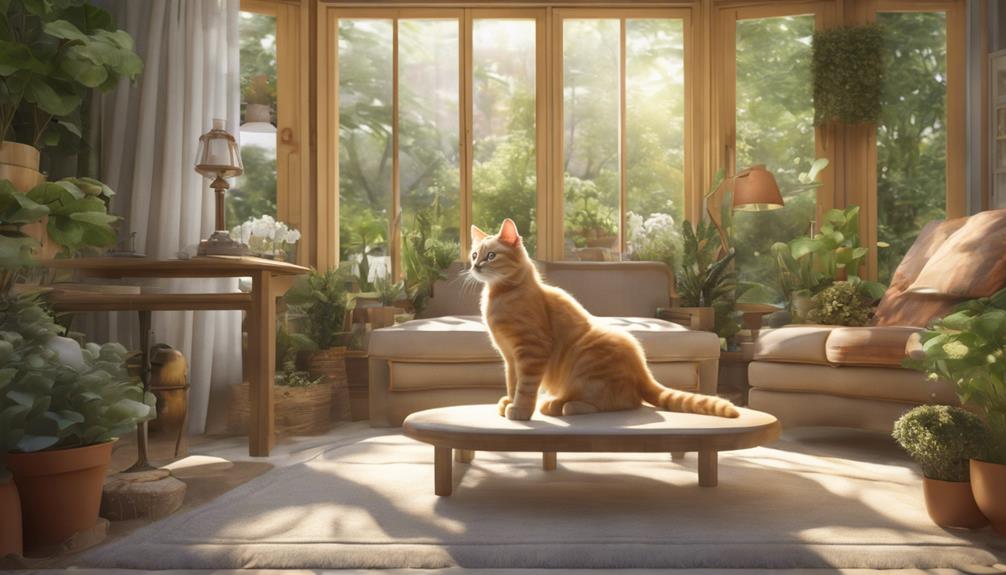
In various environments, cat pheromones can exhibit varying levels of longevity and effectiveness. Understanding these differences can help create the best environment for our feline friends.
Here's how cat pheromones can be influenced by different settings:
- Controlled Indoor Environment: Natural cat pheromones can last up to three days within a controlled indoor environment, providing a sense of security and comfort for your cat.
- Outdoor Factors: Weather conditions and interactions with other animals can impact the longevity of cat pheromones, potentially shortening their effectiveness.
- Artificial Pheromone Sprays: Artificial pheromone sprays typically need reapplication every 4-5 hours to maintain their calming effects, especially in high-stress situations.
- Emotional State and Stress Levels: Changes in a cat's emotional state or stress levels can affect how pheromones are dispersed and how long they last, highlighting the importance of monitoring your cat's well-being.
Maximizing Pheromone Benefits
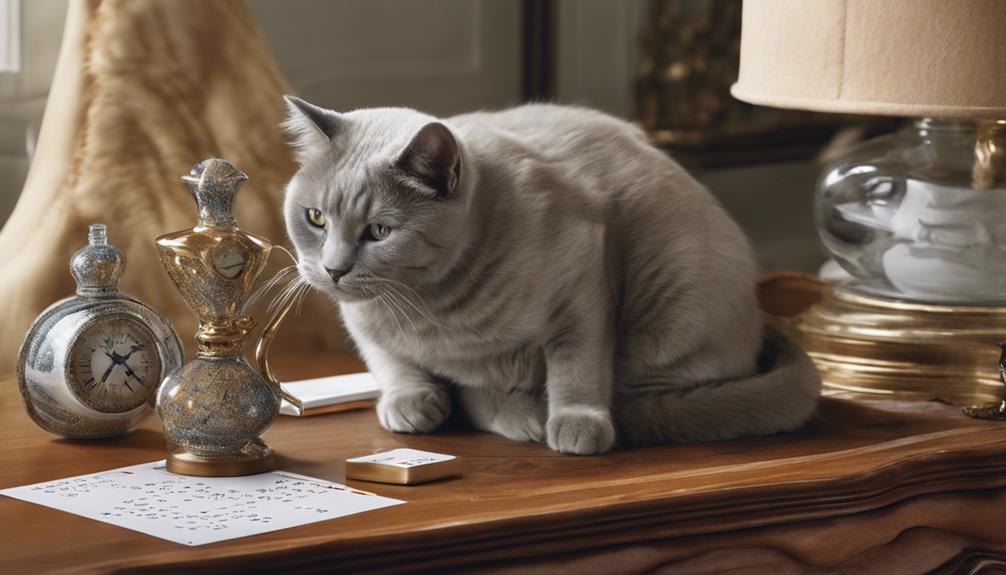
To enhance the benefits of cat pheromones, consistent application and monitoring of their effects are essential for fostering a calming environment for our feline companions.
Natural cat pheromones can last up to three days, providing a continuous sense of security for your cat.
However, when using artificial pheromone sprays, remember that these typically require reapplication every 4-5 hours to maintain their effectiveness in managing stress and anxiety in cats.
This regular use helps create a harmonious atmosphere that promotes well-being and relaxation for your furry friend.
By staying diligent with the application of pheromone products, you can maximize their benefits for long-term behavior modification in your cat.
Conclusion: Cat Pheromones Lasting Effects
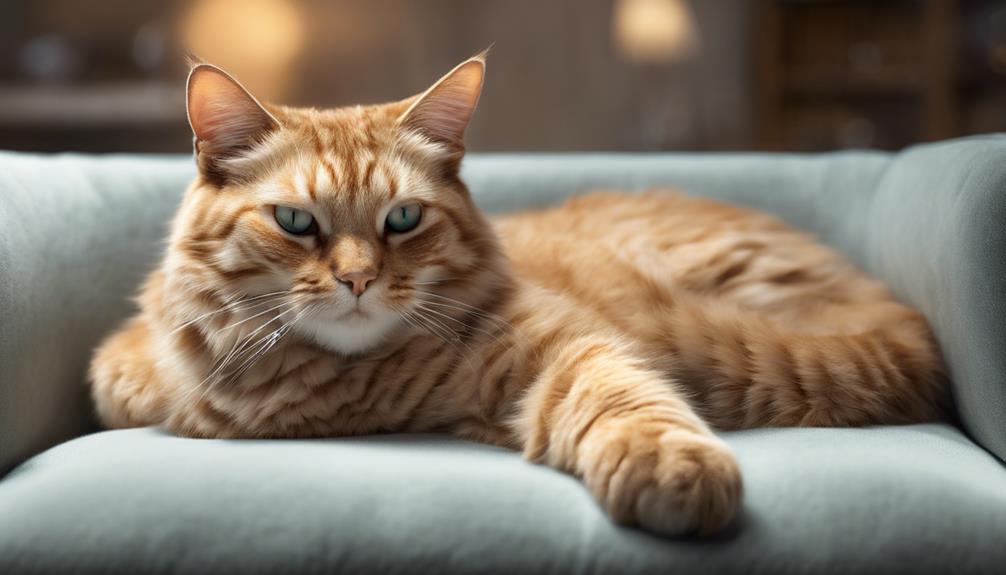
Moving on from the discussion on maximizing pheromone benefits, let's now focus on the lasting effects of cat pheromones. When considering the longevity of cat pheromones, various products offer different durations of effectiveness:
- Natural cat pheromones can linger for up to three days, providing a sense of comfort and security for your feline friend.
- Artificial pheromone sprays may need reapplication every 4-5 hours to maintain their calming effects consistently.
- Pheromone diffusers emit soothing signals continuously for about a month before necessitating a refill, ensuring a tranquil environment for your cat.
- Pheromone wipes offer temporary relief and can be used as needed to sustain their benefits, making them convenient for on-the-go calming.
Frequently Asked Questions
How Long Does Cat Pheromone Spray Last?
Cat pheromone sprays last for 4-5 hours after application. We may need to reapply for longer effects. It's best to spray 15 minutes before the cat's arrival for peak results. Avoid direct spraying and let the alcohol evaporate.
How Long Can Cat Pheromones Affect Humans?
Can cat pheromones impact humans? Unfortunately, we lack the ability to perceive these scents. Cat pheromones typically last up to three days, yet they don't affect us. Our olfactory system simply can't detect them.
Can I Smell My Cat's Pheromones?
We can't smell cat pheromones as humans, ensuring our olfactory senses remain unaffected. This understanding helps in appreciating their role in cat communication and behavior, even though we can't perceive them with our noses.
How Fast Do Cat Pheromones Work?
We notice cat pheromones working swiftly, often within minutes. Their calming effects become apparent almost immediately. Natural pheromones can last up to three days, whereas synthetic sprays may need reapplication every 4-5 hours for sustained effectiveness.
Conclusion
To sum up, cat pheromones can last anywhere from a few hours to a few weeks, depending on the type and environmental factors.
One interesting statistic to note is that studies have shown that cat pheromones can reduce stress-related behaviors in 90% of cats within 7 days of use.
Understanding the duration of cat pheromones can help cat owners effectively manage their pet's behavior and well-being.
Paul’s love for animals knows no bounds. As a dedicated writer and animal lover, Paul brings a unique perspective to our team. His firsthand experiences with various animals enrich our content and provide valuable insights into their behavior and needs. Whether he’s sharing tips for pet care or shedding light on pressing conservation issues, Paul’s passion for animals shines through in everything he does.
Cats
Common Reasons for Swollen Cat Lower Lips
Perplexed by your cat's swollen lower lips? Explore potential causes, from allergies to dental issues, for optimal feline health.
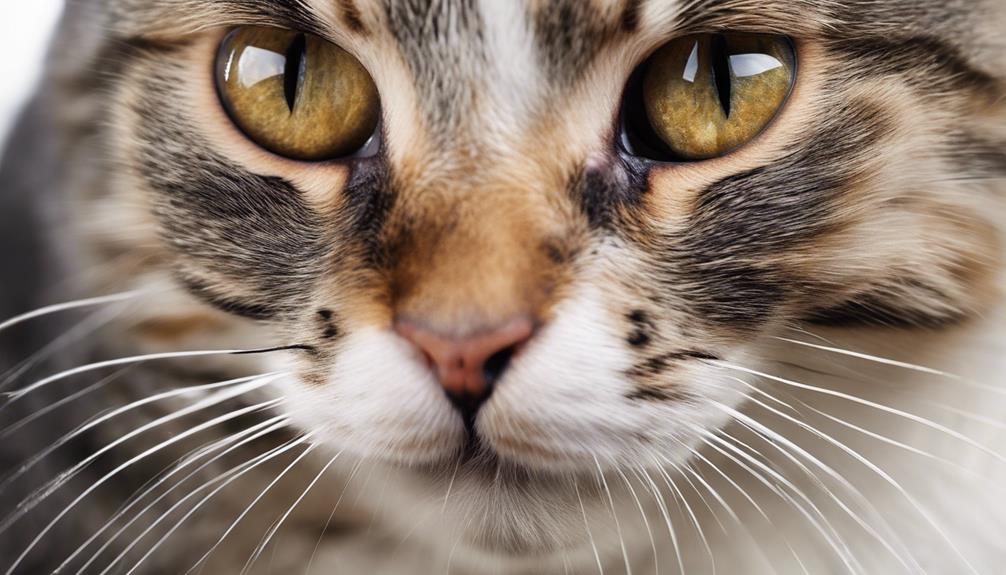
If your cat's lower lips are swollen, it could be due to a range of reasons. Allergic reactions may cause redness and itching, requiring prompt veterinary attention. Dental issues like gum inflammation and tartar buildup can lead to swelling, with professional dental care recommended. Feline acne presents as swollen lips, treated with gentle cleansing and antiseptics. Tumors, infections, and trauma can also result in lip swelling, emphasizing the need for early detection and treatment. Other possible causes include eosinophilic granuloma complex, food allergies, and periodontal disease. Understanding the root cause is crucial for your cat's well-being.
Key Takeaways
- Allergic reactions can cause redness, itching, and inflammation in a cat's lower lip.
- Dental issues like decay and gum inflammation may lead to lip swelling.
- Feline acne, characterized by blackheads and red bumps, can cause swollen lower lips.
- Eosinophilic granuloma complex presents as raised, ulcerative lesions on the bottom lip.
- Tumors, infections, trauma, and rodent ulcers are common causes of swelling in a cat's lower lip.
Allergic Reactions
When encountering allergic reactions, a cat's lower lip may swell due to hypersensitivity to various triggers. Recognizing the signs of an allergic reaction in your feline companion is vital. Symptoms like redness, itching, and swelling in the cat's lower lip area indicate a possible allergic response.
This localized inflammation can be caused by allergens such as specific food ingredients, environmental factors, or even insect bites. If you notice your cat experiencing discomfort or a swollen lower lip, immediate veterinary attention is essential. A vet can identify the allergen responsible and recommend appropriate treatment options.
These may include allergy testing to pinpoint the trigger, strategies to avoid the allergen in the future, and medications to alleviate swelling and discomfort. By addressing allergic reactions promptly and effectively, you can help your cat find relief and prevent future episodes of a swollen lower lip.
Dental Issues
When it comes to our cats' oral health, tooth decay impacts not only their teeth but also their lower lip health.
Gum inflammation can be directly linked to dental issues, leading to swelling in the lower lip area.
Additionally, tartar buildup from poor dental hygiene can have negative effects on our feline friends' lower lips.
Tooth Decay Impact
Tooth decay in cats plays a significant role in gum inflammation, infections, and swelling in the lower lip area. When dental disease strikes, it can lead to discomfort for our feline friends. Signs like bad breath, drooling, and reluctance to eat may indicate trouble brewing. If left unchecked, tooth decay can progress to abscess formation, causing swelling and pain in the lower lip.
In severe cases, this swelling can extend beyond the lip, affecting overall health. Seeking timely dental care is essential to address these issues. Professional cleaning and treatment for tooth decay not only help alleviate lower lip swelling but also make sure our cats maintain good oral health.
Gum Inflammation Connection
Swollen lower lips in cats can often be attributed to gum inflammation stemming from untreated dental issues, highlighting the essential connection between oral health and lip swelling. When it comes to dental issues and lower lip swelling in cats, several key points are important to understand:
- Periodontal disease is a common cause of gum inflammation leading to lower lip swelling.
- Untreated dental problems like infections or abscesses can result in discomfort and lip swelling.
- Foul breath may indicate underlying dental issues contributing to lower lip swelling.
- Difficulty eating could be a sign of gum inflammation affecting the cat's lower lip.
- Regular dental check-ups and good oral hygiene practices are critical in preventing gum inflammation and subsequent lower lip swelling in cats.
Tartar Buildup Effects
Excessive tartar buildup on a cat's teeth can lead to gum inflammation, infection, and swelling in the lower lip area. When tartar accumulates, it provides a breeding ground for bacteria that can trigger periodontal disease, causing redness, swelling, and discomfort in your cat's lower lip.
If left untreated, this tartar buildup can progress to more severe dental issues, worsening the swelling in the lower lip. To prevent these problems, it's important to prioritize regular dental care for your feline friend.
Professional cleanings and consistent at-home dental care can help keep tartar at bay, reducing the risk of lower lip swelling and improving your cat's overall oral health. Stay proactive in addressing tartar buildup to safeguard your cat's comfort and well-being.
Feline Acne

Feline acne in cats is a common skin condition that can lead to swollen lower lips, blackheads, and red bumps on the chin and lips. It occurs when hair follicles and oil glands become blocked, resulting in inflammation and discomfort for our feline friends.
Treatment options for feline acne include gentle cleansing, topical antiseptics, and antibiotics prescribed by a veterinarian to help alleviate symptoms and maintain skin health.
Causes of Feline Acne
Causes of feline acne commonly stem from factors such as stress, poor grooming habits, plastic food dishes, and skin allergies. Here are some key points to contemplate:
- Stress: Cats can develop acne when feeling anxious or stressed, impacting their skin health.
- Poor Grooming Habits: Inadequate grooming can lead to the buildup of oils and dirt on the chin, contributing to acne.
- Plastic Food Dishes: Bacteria can thrive on plastic surfaces, potentially leading to skin issues like feline acne.
- Skin Allergies: Cats with allergies may have heightened skin sensitivities, making them more prone to developing acne.
- Hormonal Imbalances: Fluctuations in hormone levels can also play a role in the development of feline acne.
Treatment Options for Feline Acne
When addressing feline acne, the primary focus lies in implementing gentle cleansing techniques using cat-safe products to effectively treat the condition. Feline acne treatment typically involves using topical treatments such as benzoyl peroxide or chlorhexidine solutions to help clear up the affected areas on your cat's chin.
It's important to avoid harsh chemicals or human acne products, as they can irritate your cat's skin further. In severe cases, your vet may prescribe antibiotics or corticosteroids for feline acne treatment.
Regular monitoring and follow-up appointments with your vet are essential for successful management of feline acne. By using the right cat-safe products and following your vet's recommendations, you can help alleviate your cat's acne troubles and guarantee their skin stays healthy.
Eosinophilic Granuloma Complex

We often see raised, ulcerative lesions on the bottom lip in cats affected by eosinophilic granuloma complex. This condition can be distressing for both the cat and the owner, but understanding its causes is essential.
Here are some key points to keep in mind:
- Allergies play a significant role in triggering eosinophilic granuloma complex in cats.
- Genetic factors can predispose certain felines to developing this condition.
- Environmental triggers such as certain foods or substances may exacerbate the symptoms.
- Corticosteroids and immunosuppressive medications are commonly used in the treatment of eosinophilic granuloma complex.
- Regular follow-ups with the veterinarian, allergy management strategies, and environmental modifications are vital for effectively managing this condition in cats.
Tumors and Cancer
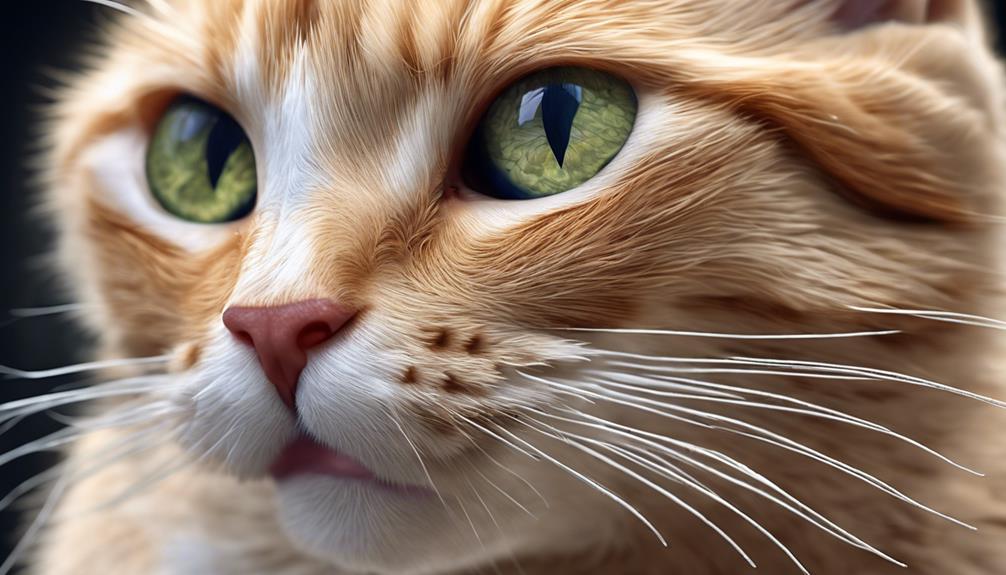
When it comes to cats, tumors and cancer can lead to swelling in the lower lip area. These abnormal cell growths may appear as lumps, ulcers, or growths on the lip.
Seeking prompt veterinary care is vital for diagnosing and determining the appropriate treatment for your feline friend.
Tumor Types in Cats
Discussing tumor types in cats involves examining various growths that can affect the lower lip, such as squamous cell carcinoma, fibrosarcoma, and melanoma. When it comes to tumors on a cat's lower lip, here are some important points to keep in mind:
- Squamous cell carcinoma is a common malignant tumor in cats, often linked to sun exposure.
- Fibrosarcoma is another type of cancerous growth that can develop in the connective tissue of the lower lip.
- Melanoma, while less common, can also affect a cat's lower lip and is related to melanin-producing cells.
- Early detection of these tumors is essential for effective treatment and management.
- Treatment options may include surgery, chemotherapy, or radiation therapy, tailored to the specific type and progression of the tumor.
Cancer Symptoms in Cats
Examining the symptoms of cancer in cats, particularly related to tumors, sheds light on the importance of early detection for effective treatment and improved outcomes.
Tumors in cats, especially those affecting the oral cavity, can manifest as lumps or growths on the lower lip, potentially indicating oral cancer. Watch out for symptoms like persistent swelling, bleeding, bad breath, and difficulty eating, as these could be signs of a more serious issue.
Remember, early detection is crucial when it comes to oral tumors in cats. If you notice any concerning symptoms, consult your veterinarian promptly for a thorough examination.
Treatment Options Available
Surgical removal may be necessary to address tumors or cancerous growths in a cat's lower lip and prevent further spread. When dealing with tumors or cancer affecting your cat's lower lip, here are some treatment options to contemplate:
- Chemotherapy or radiation therapy may be needed for aggressive or advanced cancer.
- Biopsy of the lip tissue is vital for determining the type of tumor.
- Regular follow-up appointments with a veterinary oncologist are essential for monitoring the cat's response to treatment.
- Palliative care and pain management strategies can enhance the quality of life for cats with advanced cancer.
- Consulting a Vet is pivotal to determine the best course of action for your feline friend.
Infections
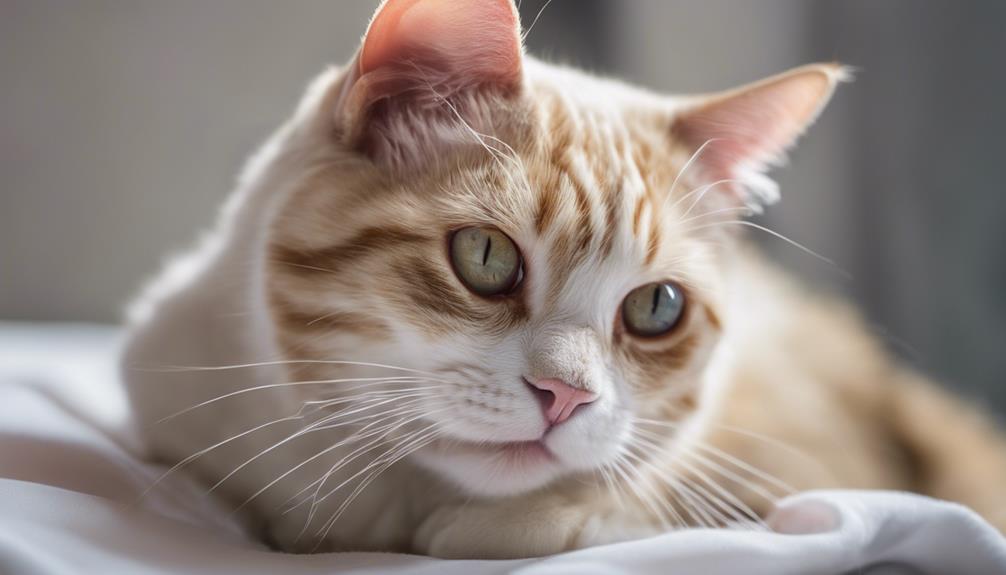
Infections present a common cause of swelling in a cat's lower lip, often characterized by redness and tenderness in the affected area. Bacterial or viral infections can lead to this swelling, with signs including warmth and discomfort. Infections in a cat's lower lip can stem from wounds, bites, or poor oral hygiene practices. It's vital to address these infections promptly to prevent complications and promote healing.
| Signs of Infection-Related Swelling |
|---|
| Redness |
| Warmth |
| Tenderness |
| Discomfort |
Treatment for infected lower lips typically involves antibiotics, wound care, and tackling the root cause of the infection. Seeking veterinary care promptly is essential for effective treatment and to safeguard the cat's well-being. By addressing infections early on, we can help our feline friends recover swiftly and comfortably.
Trauma
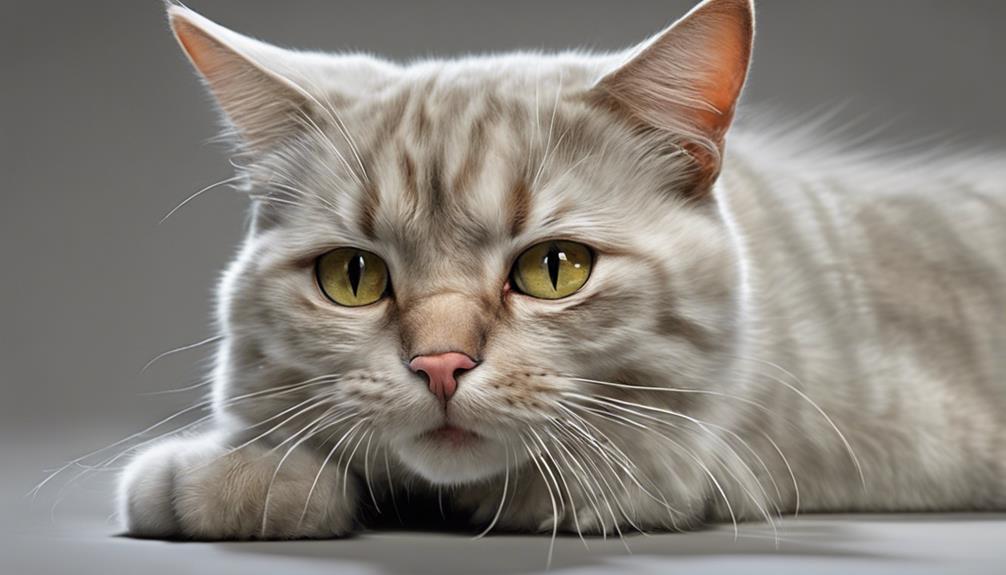
When a cat's lower lip undergoes trauma, it can be caused by various incidents such as fights or accidents. These injuries can lead to swelling, making it important to recognize signs like pain, redness, and eating difficulties.
Seeking prompt veterinary care is vital to properly address and manage any traumatic wounds in the lower lip.
Injury Causes Lip Swelling
In cases of lip swelling in cats caused by injuries, it's important to promptly address the underlying trauma to ensure proper healing and prevent complications.
When dealing with injury-related lip swelling in cats, consider the following:
- Immediate veterinary attention is essential for proper assessment and treatment.
- Proper wound care is necessary to prevent infections and promote healing.
- Antibiotics may be needed to fight off potential infections.
- Pain management is vital for the cat's comfort during the healing process.
- Monitoring for any signs of complications such as increased swelling or discharge is significant.
Ensuring these steps are taken can aid in the cat's recovery and prevent any further issues from arising.
Bites Lead to Swelling
Cat bites can lead to swelling in the lower lip area as a result of traumatic encounters or fights with other cats. When a cat bites, it can cause inflammation, redness, and tenderness in the affected area. Bacterial infections from these bites can exacerbate the swelling, making it vital to seek immediate veterinary attention.
Addressing the swollen lower lips promptly is essential to prevent complications and guarantee proper treatment. Veterinarians may recommend antibiotics, cleaning the wound thoroughly, and managing any associated pain.
Rodent Ulcers
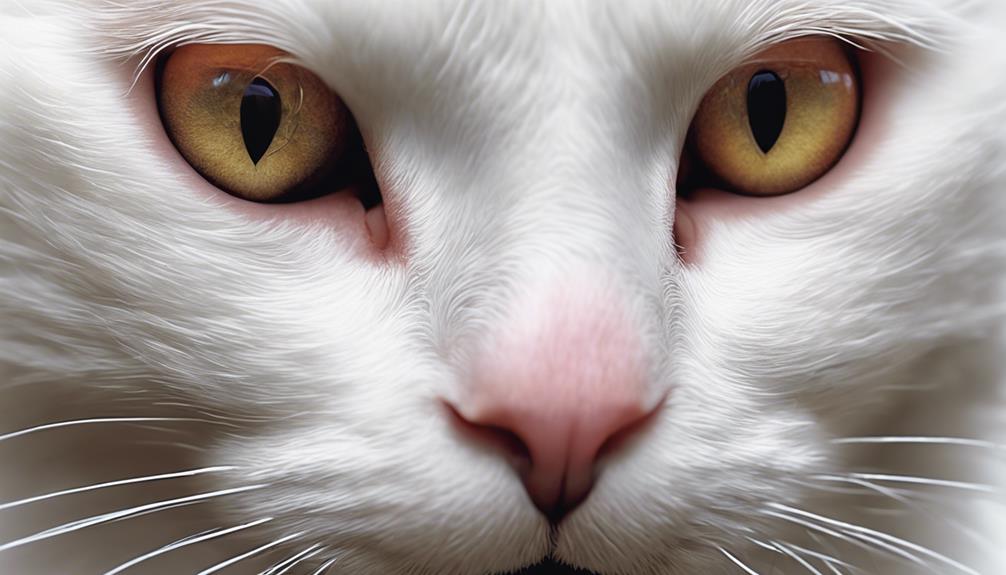
Upon examination, one may notice that rodent ulcers present as reddish, concave sores with crusty surfaces, typically situated near the upper lip and canine teeth in affected felines. Rodent ulcers are a manifestation of the eosinophilic granuloma complex in cats, impacting their skin and mucous membranes.
Here are some key points to understand about rodent ulcers:
- These ulcers can thicken over time and may develop raised borders.
- Changes in color and signs of tissue necrosis can be observed as the ulcers progress.
- Natural behaviors like licking can exacerbate rodent ulcers.
- Checking the inside of the cat's mouth may reveal ulcers there as well.
- Examining the underside of the lips can help in identifying rodent ulcers for accurate diagnosis and treatment.
Understanding these aspects can assist cat owners in recognizing and addressing rodent ulcers promptly to make sure their furry companions receive the necessary care.
Lip Granulomas
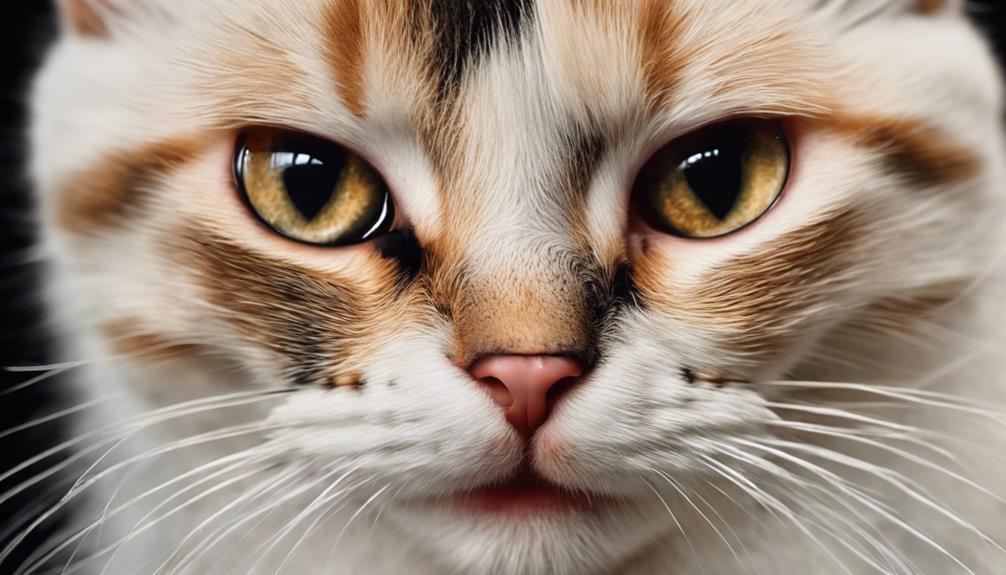
Examining the underside of the lips may also reveal the presence of lip granulomas in affected felines, which are raised, firm swellings often located on the bottom lip, particularly at the midline. These swollen areas can be part of the eosinophilic granuloma complex and may sometimes become ulcerative. Cats can develop hypersensitive reactions to allergens, food components, or environmental factors, triggering the formation of these lip granulomas.
Diagnosing lip granulomas involves a thorough dermatological examination, allergy testing, and treatment options like corticosteroids or immunosuppressive medications. Managing lip granulomas in cats requires ongoing care, including regular follow-ups, allergy management strategies, dietary adjustments, and environmental modifications to reduce triggers that may worsen the condition.
If you notice any swollen or raised areas on your cat's lower lip, seeking veterinary attention promptly is crucial for proper diagnosis and treatment of lip granulomas. Your furry companion's comfort and well-being are our top priority.
Periodontal Disease

Periodontal disease in felines can cause gum inflammation, infection, and swelling that may extend to the lower lip area. When dealing with periodontal disease, here are a few key points to keep in mind:
- Symptoms: Watch out for foul breath, difficulty eating, drooling, visible tartar, and pain in the lower lip region.
- Treatment: Prompt care is essential. Professional dental cleanings, tooth extractions if needed, antibiotics, and regular check-ups are necessary for managing the disease.
- Prevention: Maintaining good oral hygiene practices can help prevent periodontal disease and subsequent lower lip swelling in cats.
- Importance: Early detection and treatment are crucial to prevent severe health issues and discomfort that can affect a cat's behavior.
- Complications: If left untreated, periodontal disease can lead to complications like dental abscesses, which may worsen the swelling in the lower lip area.
Oral Tumors
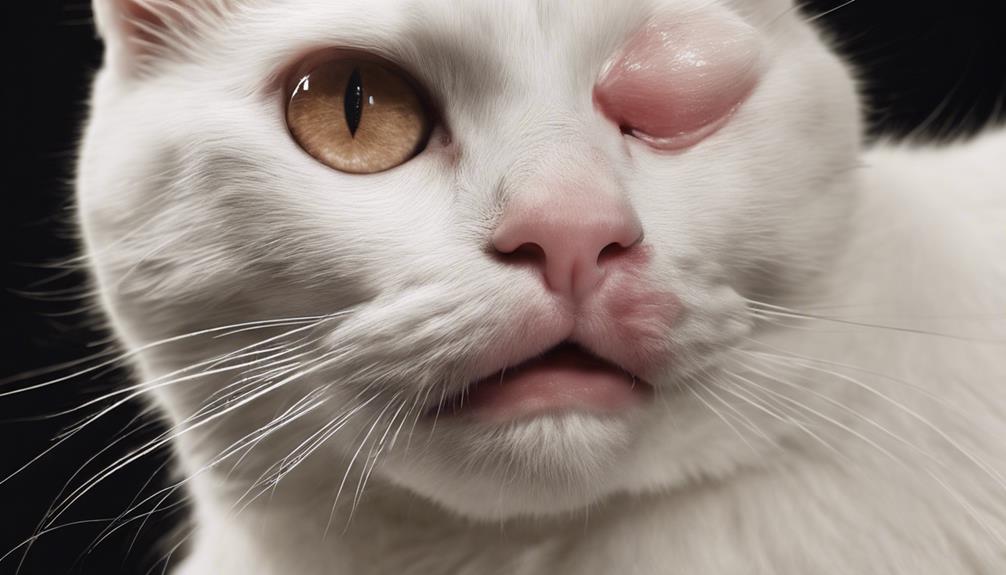
When addressing oral tumors in cats, it's important to consult with a veterinarian to determine the appropriate course of treatment based on the type and severity of the tumor.
Oral tumors can manifest as swollen lips in cats, causing discomfort and interfering with their ability to eat. Benign tumors may not always require immediate removal unless they result in noticeable swelling or affect your feline friend's well-being. However, cancerous tumors demand immediate attention.
In cases of cancerous growths on the lower lip, surgical removal might be necessary, accompanied by additional treatments to combat the cancer effectively. The swelling caused by oral tumors can greatly impact your cat's quality of life, making it crucial to address these issues promptly.
The sooner the tumor is identified and the treatment initiated, the better the chances of a positive outcome. Remember, consulting with a vet is essential in determining the best course of action for your cat's oral tumor.
Food Allergies
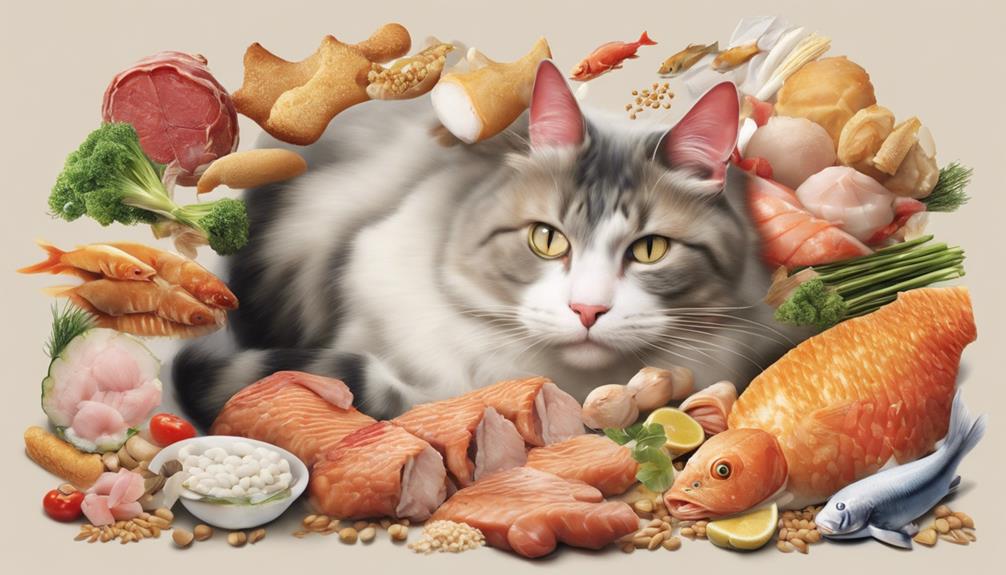
Food allergies can trigger sudden and severe swelling of a cat's lower lip following the ingestion of allergens. If your feline friend experiences lower lip swelling due to a food allergy, it's important to act promptly and seek immediate veterinary attention to guarantee their well-being. Here are some key points to keep in mind:
- Lower lip swelling from a food allergy can lead to discomfort, redness, and pain in the affected area.
- Immediate veterinary care is necessary to prevent potential complications that may arise from the swelling.
- Swelling caused by food allergies can escalate rapidly and even result in airway obstruction if not addressed promptly.
- Identifying and removing the specific food allergen triggering the reaction is essential in preventing future episodes of lower lip swelling in cats.
- Your vet can help determine the allergen through tests and advise on an appropriate diet to prevent further allergic reactions.
Inflammatory Conditions

In cats, swollen lower lips can be a result of various inflammatory conditions, including the eosinophilic granuloma complex. This complex can lead to inflammatory reactions that cause swelling in the lower lip area. Lip granulomas, a part of this complex, may manifest as firm, raised swellings on the bottom lip.
Allergic reactions to food, environmental factors, or allergens can also trigger inflammation in the lower lip region. Sometimes, inflammatory responses can occur without any visible allergens present, contributing to persistent swelling in the lower lip of cats.
It's important to promptly diagnose and treat these inflammatory conditions to effectively manage and alleviate the swollen lower lips in our feline companions. By addressing the underlying causes of inflammation, such as allergic reactions or conditions like the eosinophilic granuloma complex, we can help our cats find relief and guarantee their overall well-being.
Abscesses

Abscesses in cats commonly lead to swollen lower lips as a result of pus accumulation from infections. When dealing with abscesses, it's important to keep in mind the following:
- Signs of Infection: Keep an eye out for redness, warmth, and tenderness around the affected area, indicating a potential abscess.
- Causes of Abscesses: Abscesses can be triggered by bites, scratches, or puncture wounds that become infected, resulting in swollen lips in cats.
- Treatment Approach: Proper treatment involves draining the pus, cleaning the wound thoroughly, and administering antibiotics to combat the infection.
- Veterinary Care: Seeking prompt veterinary attention is essential to prevent complications and ensure the effective healing of abscess-related lip swelling in cats.
- Recovery Process: With the right treatment and care, most cats can recover well from abscesses, and the swelling in their lower lips should gradually subside.
Tooth Decay
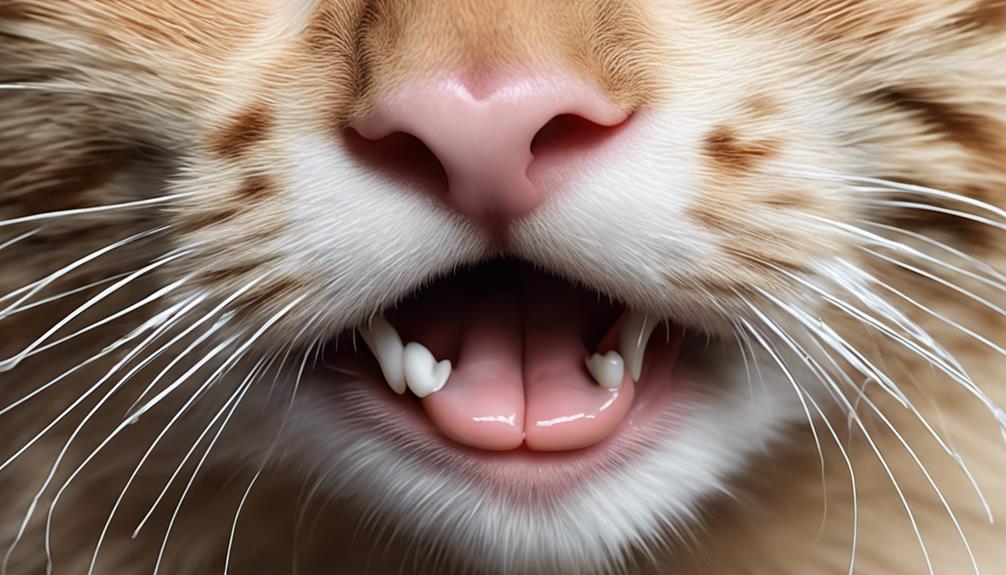
When addressing dental issues in cats, it's important to acknowledge that tooth decay can result in bacterial infections, inflammation, and swelling in the lower lip area.
Tooth decay in cats can lead to bacterial infections that may spread to the surrounding tissues, causing discomfort and swelling in the lower lip. If your feline friend is experiencing redness, pain, or difficulty eating, it could be due to tooth decay-related lip swelling.
It's essential to address dental issues promptly to prevent complications and further discomfort for your beloved pet. Treatment for tooth decay in cats may involve dental cleanings, extractions, antibiotics, and pain management to alleviate the symptoms and promote healing.
Regular dental check-ups and proper oral hygiene can help prevent tooth decay and its associated complications, keeping your cat's teeth and lips healthy. Remember, a healthy mouth leads to a happy cat!
Frequently Asked Questions
Why Is My Cat's Lower Lip Swollen?
We notice our cat's lower lip swollen. It could be due to feline acne, dental problems, or eosinophilic granuloma complex. Immediate vet care is crucial to diagnose the cause correctly and start the necessary treatment.
Should I Take My Cat to the Vet for a Swollen Lip?
Yes, we should take our cat to the vet for a swollen lip. It could be a sign of a serious health issue. Our furry friend deserves the best care, and a vet can provide the right treatment for a speedy recovery.
Why Does My Cats Mouth Look Puffy?
Our cat's mouth looks puffy due to various reasons like inflammation, infection, or allergies. Observing changes helps identify issues early. We consult a vet promptly for the best treatment plan. Monitoring our cat's health is essential.
Can Cat Allergies Cause Swollen Lips?
Yes, cat allergies can cause swollen lips. Allergic reactions trigger immune responses leading to inflammation and discomfort. Identifying allergens is paramount. Symptoms like redness, itching, or sneezing may accompany swollen lips. Managing allergies is essential for preventing recurrence.
Conclusion
To wrap up, swollen lower lips in cats can be caused by a variety of factors, including allergic reactions, dental issues, and feline acne. It's important to consult with a veterinarian to determine the underlying cause and provide appropriate treatment.
Just like how we seek medical attention when we've a swollen lip, our feline friends also deserve the best care to ascertain their health and well-being. Remember, a little TLC goes a long way in keeping our furry companions happy and healthy.
Paul’s love for animals knows no bounds. As a dedicated writer and animal lover, Paul brings a unique perspective to our team. His firsthand experiences with various animals enrich our content and provide valuable insights into their behavior and needs. Whether he’s sharing tips for pet care or shedding light on pressing conservation issues, Paul’s passion for animals shines through in everything he does.
-

 Vetted2 months ago
Vetted2 months ago15 Best Cat Foods for Managing Hyperthyroidism – Vet Approved and Feline Friendly
-

 Vetted2 months ago
Vetted2 months ago15 Best Dog Foods for Kidney Disease – Expert Recommendations for Your Pet's Health
-

 Vetted2 months ago
Vetted2 months ago15 Best Fresh Dog Food Delivery Services for Your Pup's Health and Happiness
-

 Animal Facts2 months ago
Animal Facts2 months agoSpring Animals: A Guide to Seasonal Wildlife
-
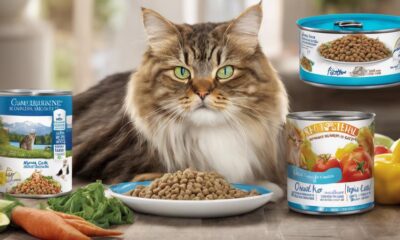
 Vetted2 months ago
Vetted2 months ago15 Best Wet Cat Foods for Older Cats to Keep Them Healthy and Happy
-

 Cats1 month ago
Cats1 month agoCat Weight Chart by Age: Kitten to Senior in Lbs
-

 Cats1 week ago
Cats1 week agoTop 5 Cat Breeders in Arkansas: A Guide
-

 Vetted2 months ago
Vetted2 months ago14 Best Homemade Dog Food Recipes Your Pup Will Love – Vet Approved & Nutritious



















